At the detective agency, we have been preoccupied in recent years with the Dollhouses of Omaha. Tonight’s collection of structures is reminiscent of the miniature world, embodying a delightful, visually appealing quality that prompts the viewer to contemplate scale… and reality itself. These are a few of the Little Whimsies that captured my heart in childhood and a few others I have tracked down over time. If you have not yet had this experience, the enchanting nature of imagining that one is observing a miniature on the city streets can evoke a surreal Alice in Wonderland experience. Although entering the imaginary realm of the Lifesize Dollhouses can pique a rare fairytale experience, I perceive this selection of Dollhouses of Omaha as distinct from the meticulously designed fairytale cottages and storybook houses, which were explicitly crafted by their architect to transport both their life-sized occupants and viewers to a bygone gnome’s or milk maiden’s tale.
The following photographs illustrate the fairytale and storybook variety. The handcrafted charm in these residences is evident, allowing the observer to comprehend the narrative conveyed by the architect— a tale as timeless as our childhood literature.
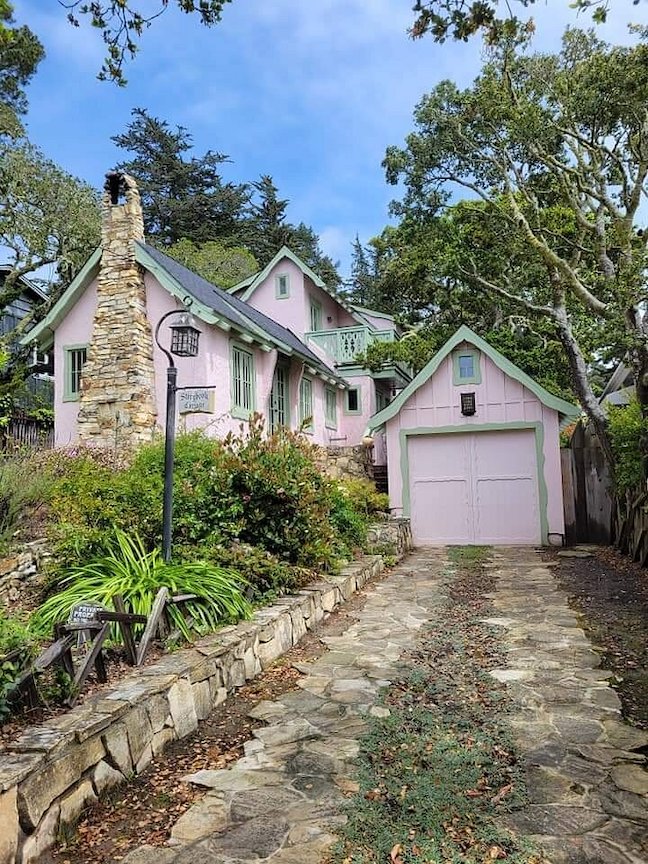
Storybook Cottage, in Carmel-by-the-Sea, California, was designed by Hugh Comstock and Michael J. Murphy in the 1920s.

The Hansel Cottage, in Carmel-by-the-Sea, was designed by Hugh Comstock and Michael J. Murphy in the 1920s.

The Witch’s House in Beverly Hills, CA, was designed by Harry Oliver in 1921. Photo by Douglas Keister.
Alas these California fairytale gnome cottages are not what we are investigating. We are casing Twee Houses or buildings that resemble Dollhouses.
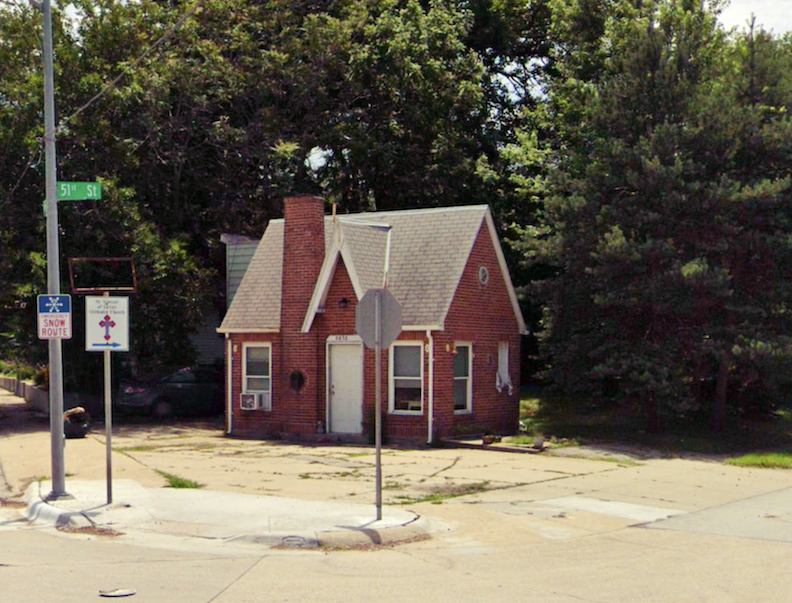
Observing human scale architecture, all the while having the immersive experience of dreaming one is viewing a dollhouse surely pertains to imagination and susceptibility to fantasy world sway, but I do believe that scale, perception of preciousness, a distinct, minute narrative conveyed through architectural design, purposeful lighting, perhaps landscaping or lack of and positioning on the parcel of land certainly heightens the sensory experiences and lends itself to the psychological storytelling. When I begin to “see” a miniature house in the real world, I am almost immediately captivated by a sense of wonder and nostalgia, accompanied by a need to get closer and understand. My mind smiles. Was it carefully plotted by the architect/builder or is it a magical accident?

Illustration from Lewis Carroll’s famous 19th century novel, Alice’s Adventures in Wonderland.
I have written previously about how Disneyland and Disney Parks around the world employ forced perspective, a technique that alters the scale and positioning of buildings relative to the viewer’s perspective. Disneyland architecture is designed to generate optical illusions, causing the human eye to perceive size and distance in an altered way. For example, upper levels of buildings are reduced in scale, creating an illusion of greater height–in the case of the castle, producing a sense of height and grandeur from afar. Most of their uses of forced perspective seem to involve making a building or mountain much taller and spectacular.
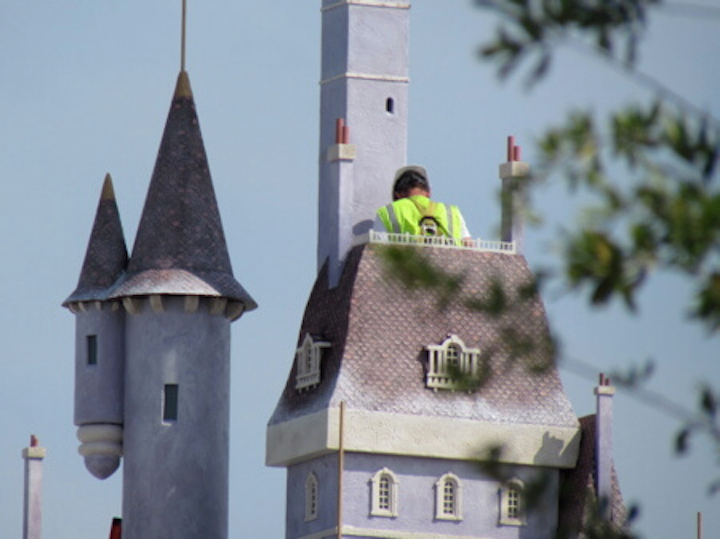
Disney worker fixing a castle.
Although I am captivated by this concept, and probably think about it too much, I am uncertain that the approach is what I am perceiving in tonight’s case study. It is actually the contrary effect. The siting of these particular Omaha structures, their very isolative* positioning on the parcels, and the absence of surrounding structures for size comparison and orientation has resulted in a diminutive effect. What must enhance this type of “small perspective” is a particular architectural design. I only know it, when I see it and I would appreciate insights from fellow miniature seers or any architects’ evaluation, for that matter. I must assume this obsession is related to my childhood fascination with dollhouses.
*To the person who wrote the snippy review of my book and website, I have chosen the word isolative purposefully. I understand and acknowledge that the terminology I have chosen and continue to use describes humans and human conditions. Yes, I do take liberties. One would gather through trying on the glasses and experiencing houses in the suggested, personified light, that I am describing architecture as if the buildings hold human characteristics and personality, which they do, to my senses.
Let me gather myself…
Here I am with my dollhouse in sweeter times.
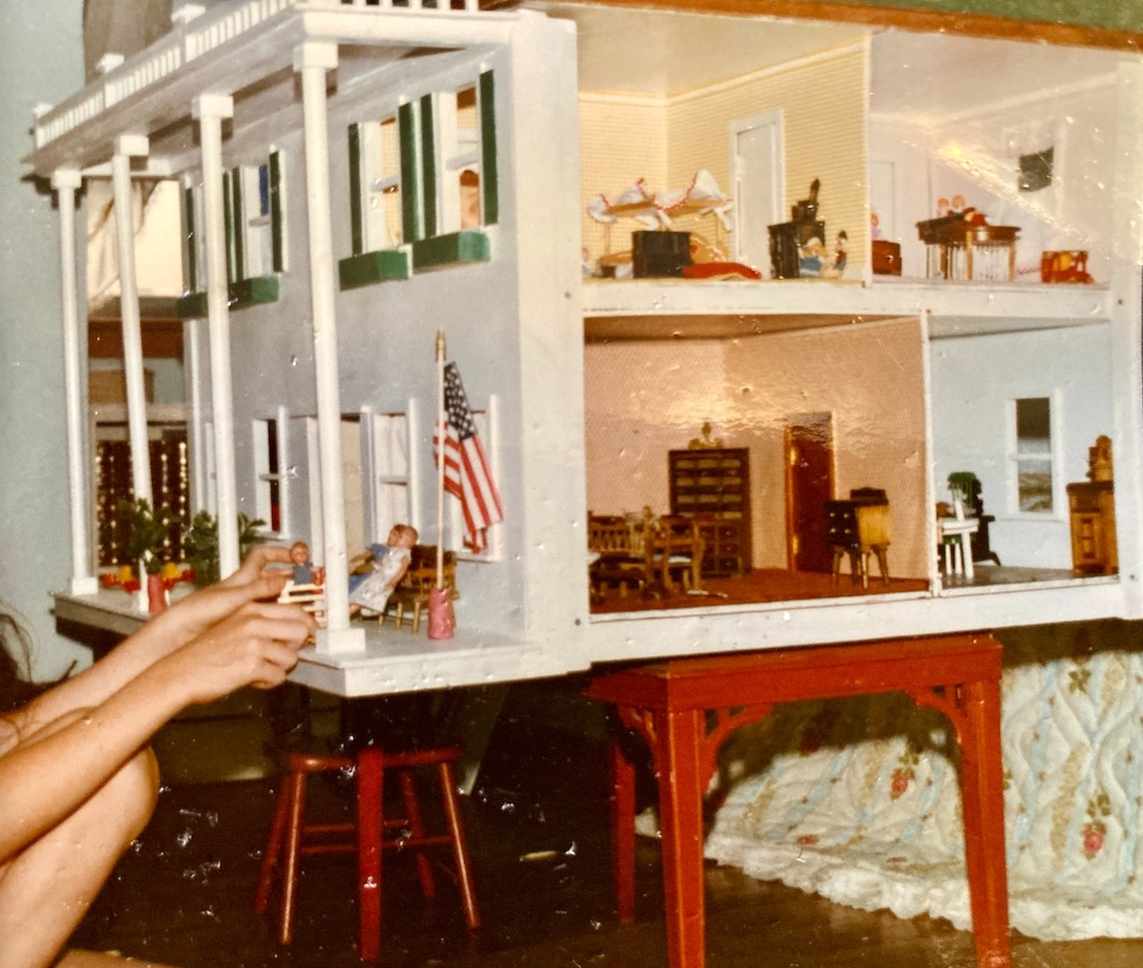
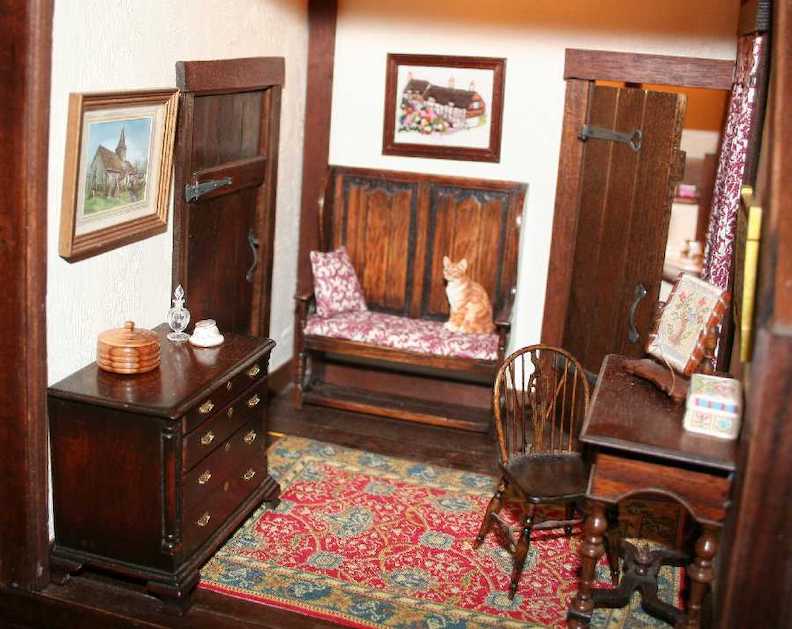
The miniature obsession continues…
Apparently neurological conditions can lead architectural structures to appear skewed in scale, resembling miniatures. Interestingly Alice in Wonderland Syndrome (AIWS), or Todd’s Syndrome, is a rare neurological disorder that alters the brain’s processing of sensory information, resulting in perceptual distortions. Individuals with AIWS may experience Micropsia, wherein items appear smaller than their true size. Sleuthing friends, I am no expert and could not attempt to talk about these diagnoses or drug-induced-miniscule-experiences, for that matter. Miss Cassette is merely addressing the delightful, heart skipping parallels between dollhouses and actual human residences.
The dollhouses in Omaha are few and far between. On that note, please help us in finding more Twees for our Dollhouses archive. In my estimation, factors contributing to the Dollhouse Aesthetic: There is a tidiness to them, as if they were produced on a 1950s dollhouse assembly line involving elves or imbue the intricacy of being glued together by a fastidious grandfather in his basement ham radio workshop. The homes you will see tonight exude a quiet allure from streetside, including steeply pitched roofs, Lilliputian hallucination windows and pathways, intricate trim, strange and wonderful tilework, detailed woodwork or decorative ironwork, soft shades, small and well-proportioned, gabled roofs, interesting dormers, Barbie’s balconies, tiny porches and playful architectural elements that can appear almost toy-like in their simplicity. The Dollhouse structure seem to just exist in isolation. It is their wondrous placement. The neighboring houses fade away like mist.
Please join me in tracking these small obsessions.
5035 Northwest Radial Highway

This little darling at the corner of Fifty-first Street and Northwest Radial drove the 1970s and 80s children of Benson mad. A petite, brick, Tudor-style with the steeply pitched roof and mini-chimney is located at 5035 Northwest Radial Highway and is purported to have been constructed in 1929. Literally placed like a dollhouse out among the many businesses and regular size residences along the busy thoroughfare, she is a mystery by our contemporary standards. I never knew any of her history—deciding to allow this conspicuous dollhouse to remain what she is–precious and weird.
I found this building had predominantly carried the postal address of 5035 Military Avenue. Military Avenue, along this length, was renamed Northwest Radial in 1951, causing difficulty for many who are not from Benson, presenting a curious problem even for locals. This appeared to be of little consequence to the small businesses and residences along this stretch of road. There were decades when her two addresses were interchangeable. It is amusing to consider that 5035 Military Avenue, the parcel, was once a proper five-room house with a garage before it was demolished and reconstructed as a diminutive, faux-house-filling-station by the Phillips 66 Company. Could they have anticipated that this miniature construction would persist in provoking the tranquil neighborhood to the south? This diminutive Tudor has generated considerable attention over the years as its successive owners endeavored to transition her to a traditional sized structure from its original 260 square feet. (More on this later.) 5035 Military Avenue/Northwest Radial currently measures 468 square feet.
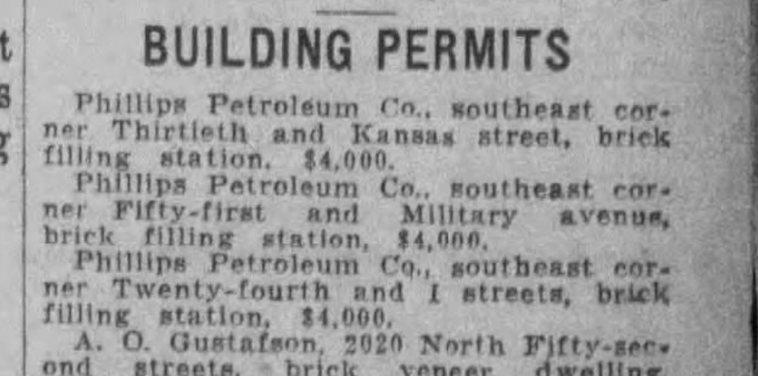
June 1929. Omaha Evening Bee News. It looks like three Phillips Petroleum gas stations were being constructed.
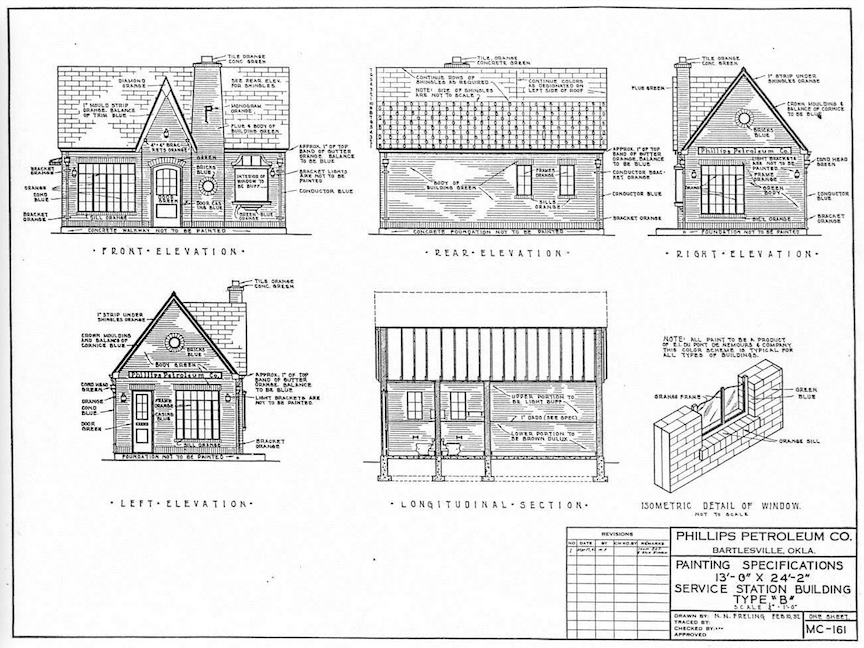
“Type B Service Station Building” from the Conoco Phillips Petroleum Company. Our little 5035 Military Avenue/Northwest Radial was of this design. Texas to Minnesota, and from Colorado to Illinois, Phillips would construct more than five hundred of this dollhouse or “cottage-style” service station.
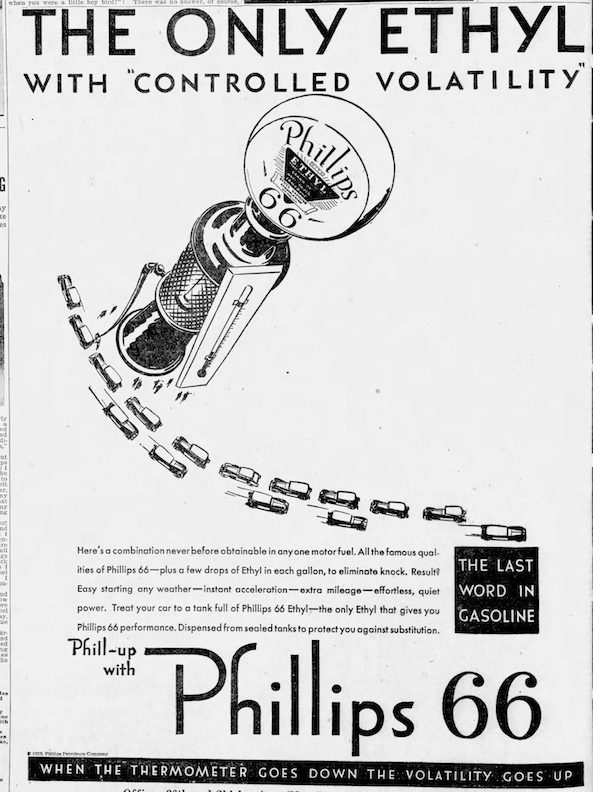
October of 1929. Omaha World-Herald. The first advertisement that I found for filling station at 5035 Military Avenue. This is a great example of what the antique gas pumps would have looked like out front–now paved over.
In 1928, the Lee La Argo frame lunchstand at Fifty-first and Military, thereafter, known as Earl Morning*’s hamburger hutch, along with the Charles W. Bonde Florist business and an unnamed fruit tree and shrub vendor, established a consistent clientele on the periphery of the Country Club neighborhood. Surrounded by their businesses, Phillips 66 began building the small, “Tudor cottage-style,” as they called it, on the corner. Phillips distinguished building was one of a series of enterprises characterized by the 1920s faux residential aesthetic typical of service stations of that era.
*We could have done so much more with the name Earl Morning. This name BEGS, it pleads, for the proprietor to have owned a breakfast-only diner.
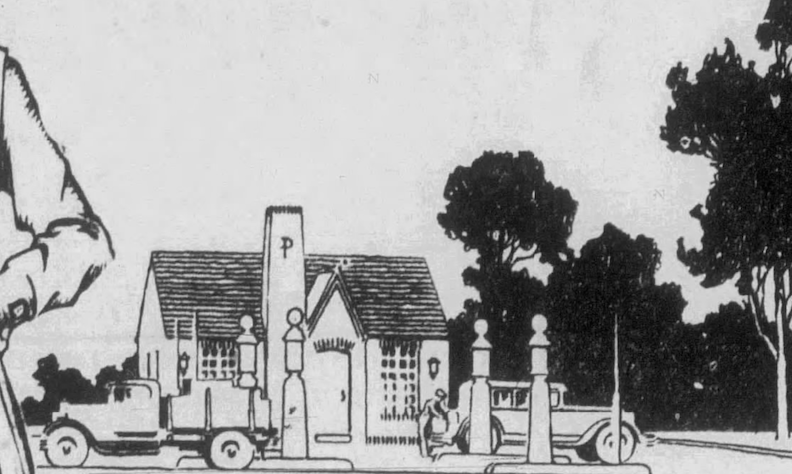
1930. Omaha World-Herald. The adorable Phillips 66 look from late 1920 through the 1930s. This gives us an idea of the original door and windows, sconces and high hopes for a “P” on that chimney.
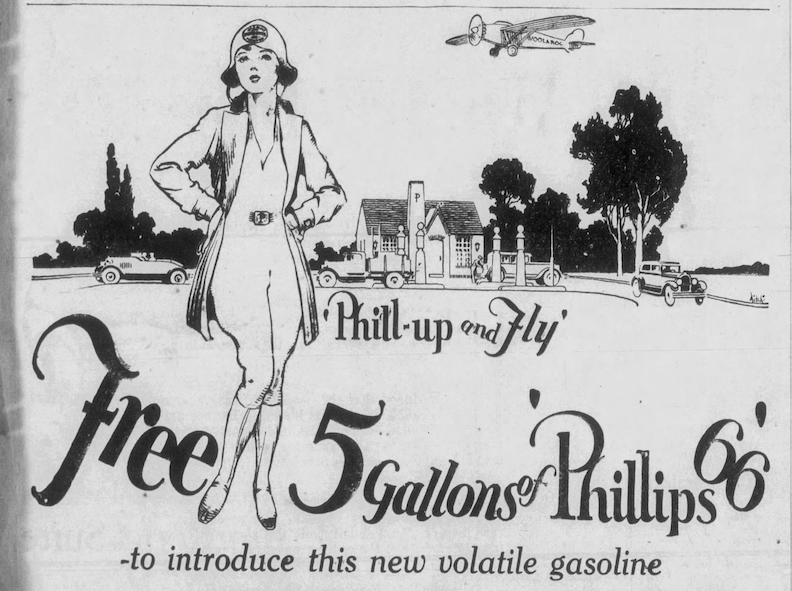
The whole advertisement from May of 1930. Glorious. The 5035 Military Avenue address and that of their other Omaha locations were seen at the bottom of the page. Omaha Evening Bee. News.

5035 Northwest Radial. Western side. Wonderful, decorative glass disc reads Phillips 66.
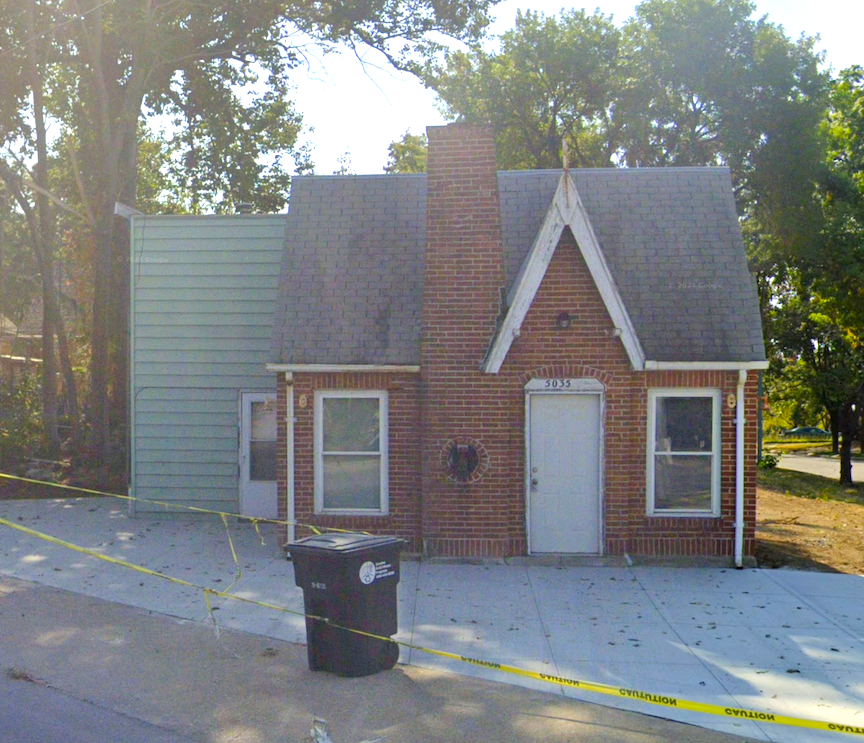
As touched on earlier, 5035 Northwest Radial is seen in isolation. Without neighbors, orientation and context is lost and the perfect little structure becomes a miniature when driving down the road. Go have a look. It is disorienting in the best way.

This investigation would explain the fascinating Phillip’s 66 glass logos that can be seen on the east and west gables of the filling station dollhouse.
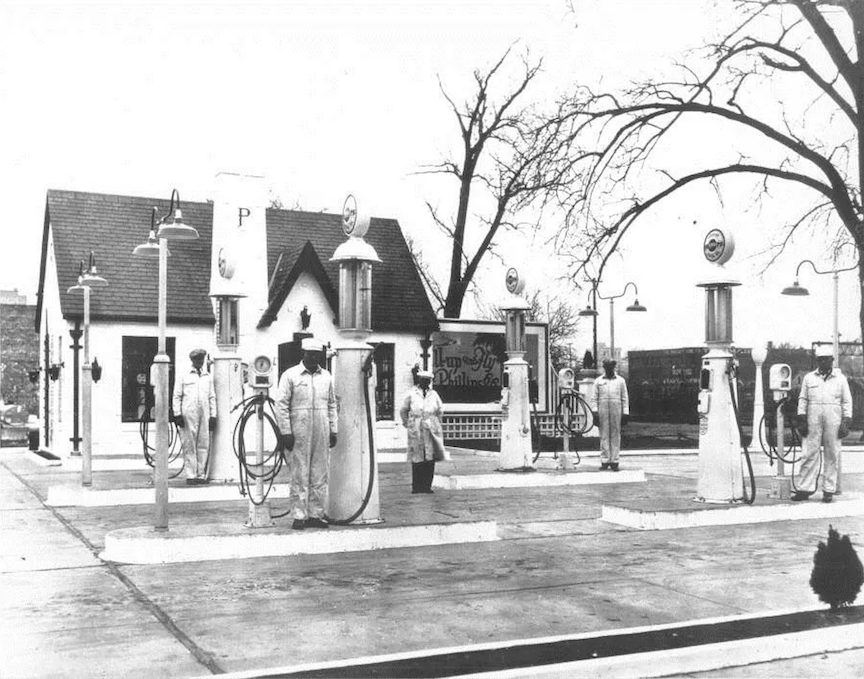
Delighted to find this one in the eleventh hour of this investigation. Opening day at the first Phillips 66 station in Wichita, Kansas. Photo by the Conoco Phillips Petroleum Company.
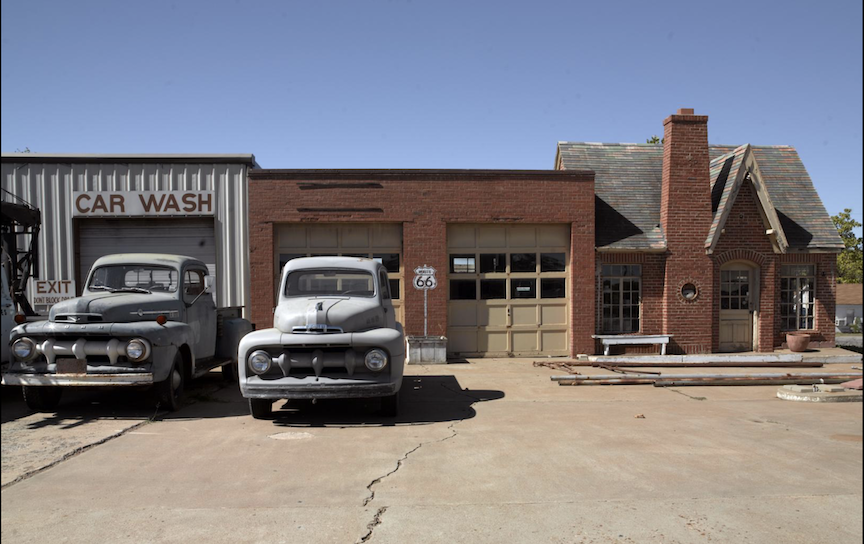
Vintage Phillips 66 Gas Station with expansion over time and historic cars. Route 66. Chandler, Oklahoma. Highsmith, Carol M., 1946-, photographer. This example shows us what the windows and door would have looked like. Also looks like the original tile roof.
The mini station at Fifty-first and Military would undergo numerous ownership transitions. By 1932, it was owned by Deep Rock Oil. In 1949, Jim Whalley established his Jim’s Cities Service filling station. Mr. Whalley would then petition the City Planning Commission to rezone both sides of Military Avenue between Forty-ninth Avenue and Fifty-second Street from residential to secondary commercial use. Mr. Whalley stated his intention to construct a two-stall extension for oil and grease operations at his filling station. For more context, the plot on which the service station is situated extends southward into a residential area. I have come to believe that this is the fundamental issue. Neighboring homeowners including Reverend A. C. Burroughs, pastor of Bethany Lutheran Church at Fifty-second and Military, stated that rezoning would diminish the value of the church land and adjacent residences. The city announced that Military Avenue would remain residential. Mr. Whalley made another attempt in 1955. After his expansion plan was once more denied on appeal, he relocated his business, by then renamed, Jim’s City Service, to North Sixty-fourth.

The 5035 Northwest Radial Highway/Military Avenue parcel is highlighted in teal. The aerial photograph is orientated with north positioned at the top of the image. The Northwest Radial intersects at an angle. The elongated parcel indicates that a residence could have been positioned within the appropriate neighborhood grid, orientated towards the west on North Fifty-first Street. Most likely the phantom house was torn down when the gas station was built. These past city planning decisions were made when Military Avenue was moving from a residential street to commercial district and a busier thoroughfare. It has been a mishmash for as long as anyone alive can remember. The tiny Phillips 66 building is locked into this strange city problem. Image borrowed from the Douglas County Assessor site.
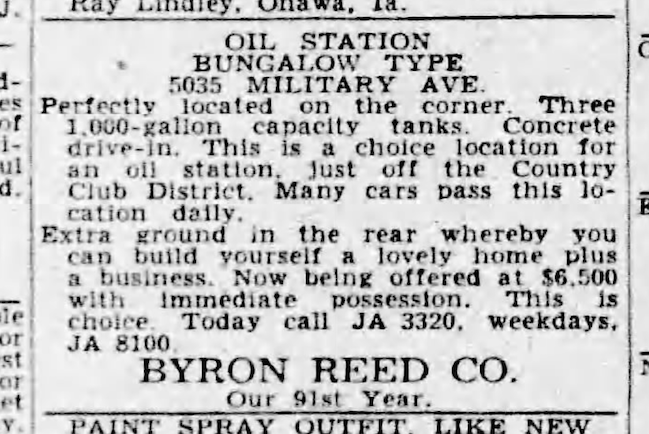
1947. Omaha World-Herald. “Bungalow type.”
The rapid rentals and ownerships persisted. In 1955, Mr. Van W. Harman transferred ownership to Crest Service Inc. Oddly, the Rotella family operated the station under the City Service name. In 1957, Paul Cieciora managed the Crest Service Station. By 1958, Marion’s Frontier Service had assumed control of the keys. Crest Frontier Station, a prominent chain, had merged with Frontier, remaining at 5035 Military, then seemed to merged with Vickers. By the early 1960s Crest Vickers had hung their sign. The mid to late 1960s brought in Al’s TV and Record Shop, and B. K. Mower Repair. Various auto sale businesses rented throughout the 1970s.
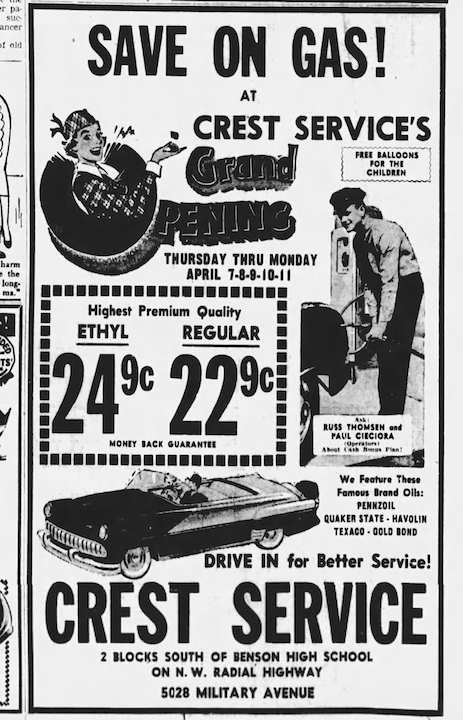

1955 Crest Service advertisement. The Crest Vickers ad is from 1964. Haven’t seen that logo in a long, long, long while.
Another owner, Albert and Virginia Treutler, sought to rezone the tiny building at 5035 Northwest Radial to commercial zoning to expand the existing structure for use as an advertising agency and copy shop. A proposal has been made to transform a “50-year-old gas station” into an advertising agency. Once again, this was denied by the city.
So, in 1981 the Treutlers put the wee brick building up for sale. No one bought it. The Treutlers again went before City Planning. This time, in 1984 several residents testified against the proposed expansion of the “abandoned gas station” from residential to commercial. Mr. Treutler wanted to add 320 sq ft to the 260sqft. He had no tenants lined up but has had inquiries from artists and businesses such as drive in restaurants, ice cream shops and workshops. Not allowed.
By the early 1980s the Treutlers had gotten the message and 5035 Northwest Radial was rented out as a residence. The owners were able to make what appears to be two additions to augment the square footage and render the little petrol station habitable. She has been a proper, albeit, diminutive home for this entire period.
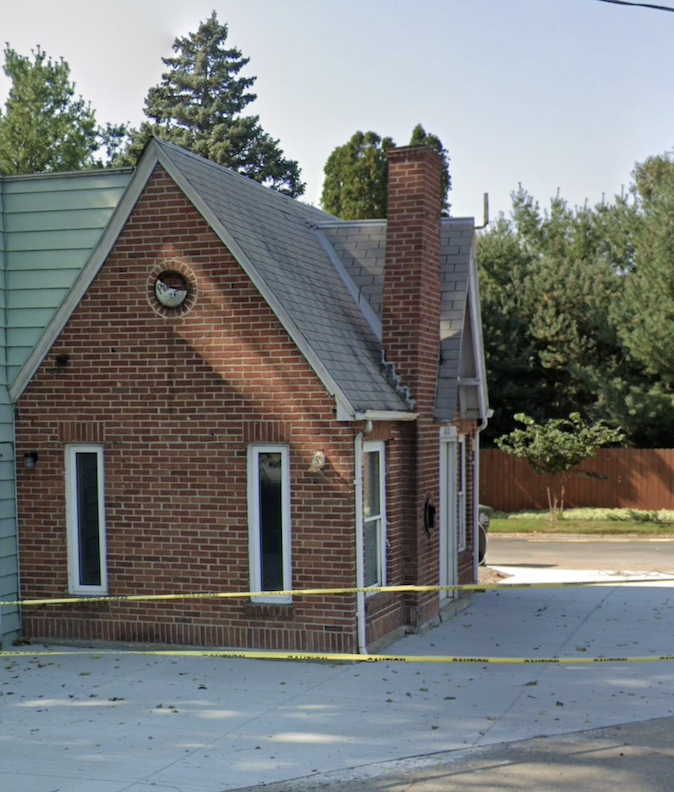
East elevation of the original filling station structure.

5035 Northwest Radial. Western elevation.
Cute as a button in its design, until the exceptionally odd but seemingly needed addition/or additions occurred. As if two unknown buildings snuggled up next to our brick dollhouse one winter night and never left.
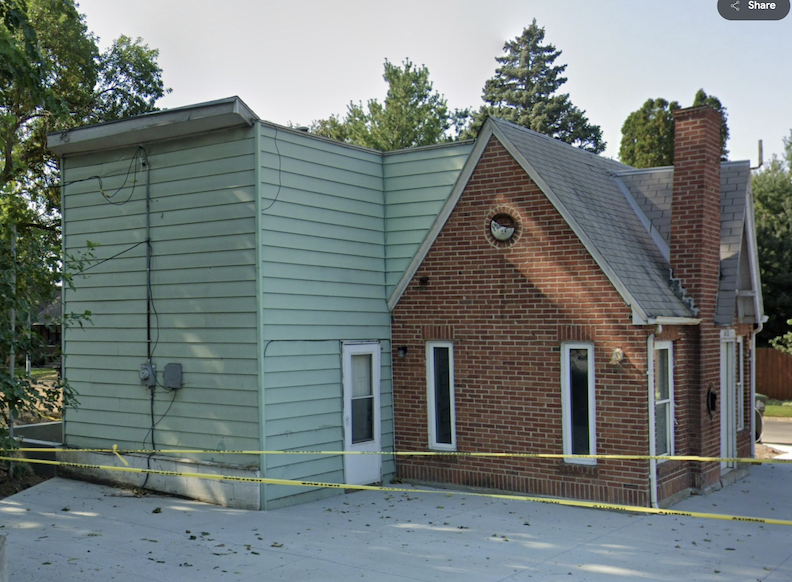

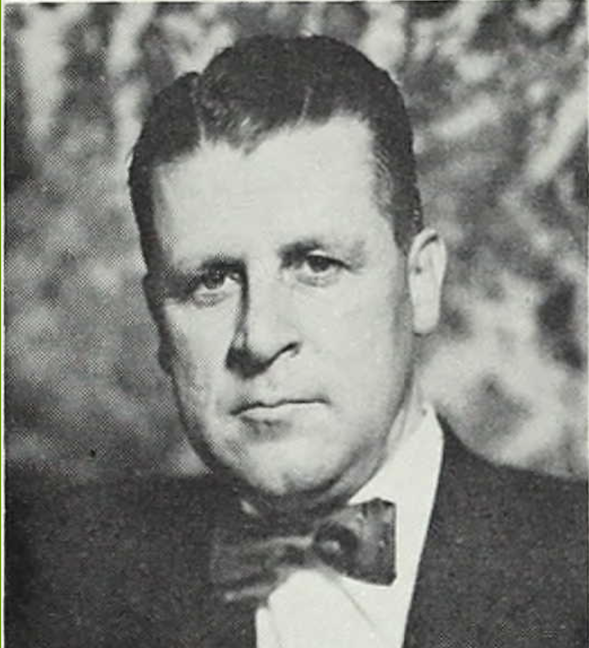
Architect Leo A. Daly, Jr.’s general expression reflects the approval rating of these sad, seafoam green additions.
No one understands what they are looking at with these additions but at the end of the day, I am just glad that the service station portion remains. The addition can or should be removed or reconfigured. My summary of this whole dollhouse filling station mystery is that while one can dismantle an authentic home to create a small business resembling a dollhouse, the physical dimensions of the business cannot be enlarged; yet the simulated house can be transformed into a genuine residence.
Love vintage filling stations and want more? Check out my earlier investigation: Magnificent Obsession: 1928 Leavenworth Street.
830 North Eighty-ninth Circle
The glory at 830 North Eighty-ninth Circle never ceases to amaze. I conducted an extensive investigation in the past. Kindly peruse the case at your leisure: Mysteries of Omaha: 830 North 89th Circle. Today, I am presenting a selection of photographs from that research, anticipating that you will revisit the complete narrative at your convenience.
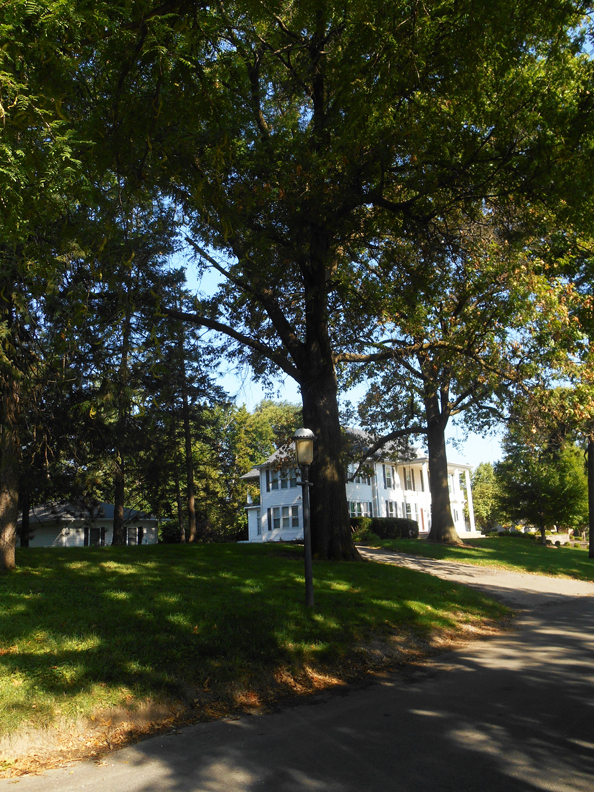
Forced perspective. A dollhouse has been discovered in the distant wood.
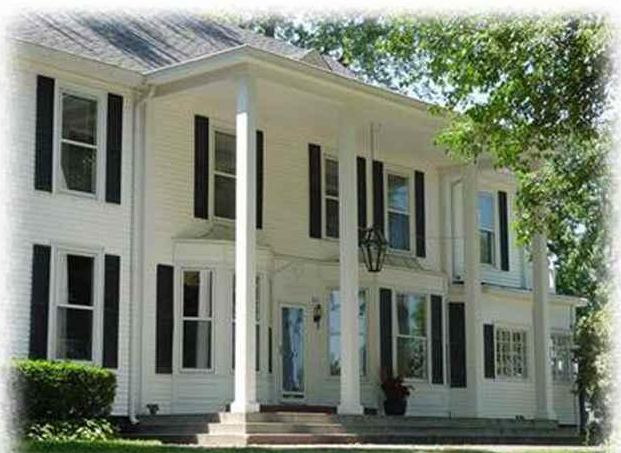
Even up close, the formality and scale suggest a miniature model. Dare I say, an illusion.

Even the aerial suggests a dolls’ house. Eastern elevation of 830 North 89thCircle. A study of the current home’s rooftop will show a menagerie of dreamy shapes, and curious connecting seams, any of which might be concealing the original home. I love to ponder this. Aerial photographs from the Douglas County/Omaha NE GIS Department website.
7826 Military Avenue
Any child of Benson acquainted with the Keystone neighborhood recognized this striking dollhouse landmark. It was located immediately west of Mount Hope Cemetery. In addition to the small dollhouse, which I now realize was a gas station, this charming Tudor-style residence on Military Avenue was my initial encounter with the hope of witnessing an authentic miniature house. Throughout my years of passing this residence, I have never encountered a human, nor have I ever approached it. She didn’t used to have a circular drive or the hardscaping off the drive or up to the porch, which served to create a very long sweep of front lawn and a dramatic high rise view of the dollhouse. It was a puzzle. How did this house all fit together? Due to its distance from the road and the absence of nearby structures, these conditions, as previously described, permitted me to indulge in my dollhouse dreams freely without obstruction. This home is my Number One standout from childhood, among many beloveds.
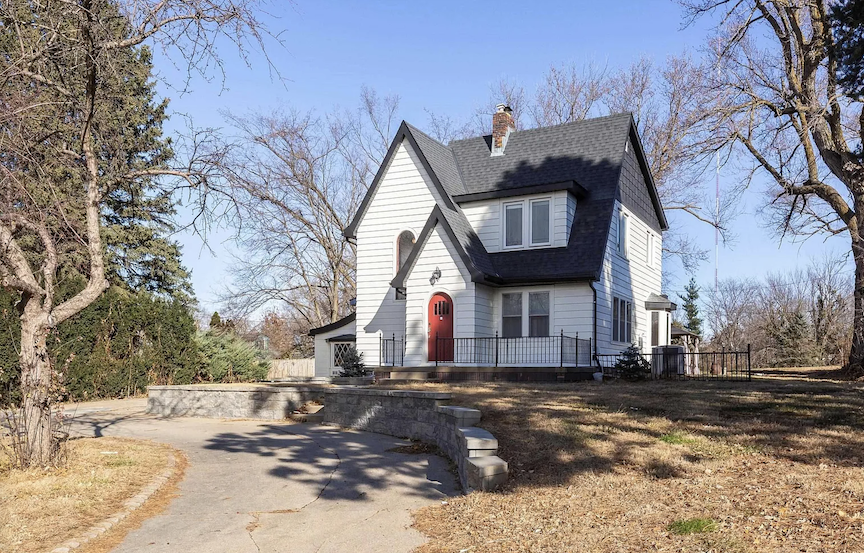
7826 Military Avenue was built in Lot 39, Block 0 of the Pinecrest Addition. This wonderous home is purported to have been constructed in 1931. She just sold in September 2024, following a significant refurbishment. I believe we are all aware of my opinion regarding a spiff up. Some of these changes are beneficial.
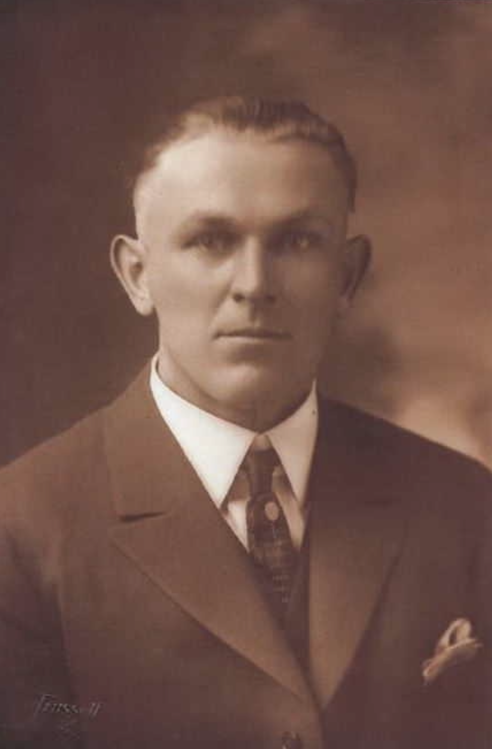
Henry Hasenkamp photo by Diane Cowan.
Heinrich Gustav (Henry) Hasenkamp was born in 1884 in Bulkau, Germany. He emigrated to the United States in 1889. Mr. Hasenkamp was identified as a carpenter specializing in building construction. According to my research, Henry G. Hasenkamp and his spouse, Stella Dickerhoff Hasenkamp, also recorded as Stella M. Cousins Hasenkamp (born 1882), were wed in 1910 in Council Bluffs. The couple had no children. I discovered evidence of the Hasenkamp pair engaging in their own design and construction business in Omaha as early as 1913. This was pretty thrilling to me.

The dollhouse perfection at 7826 Military Avenue was conceived and constructed by the Hasenkamps for their own use, and it is evident. They cherished their residence, worked hard on it and had settled their mortgage by 1937.

Previous to its recent remodeling and sale, this photo more closely resembled the past memory–although that front elongated window is not altogether right. The front porch, the hardscaping and the classic swooping Tudor garage refashioned into a bay window is all different. My Omaha Obsession sleuth, Olive Ramsey, commented she had been inside 7826 Military Avenue while the refurbishing was in progress in the 2005-2010 time period. That remodeling project held to the original architecture, in her estimation. She remembered the backyard as “an oasis.”
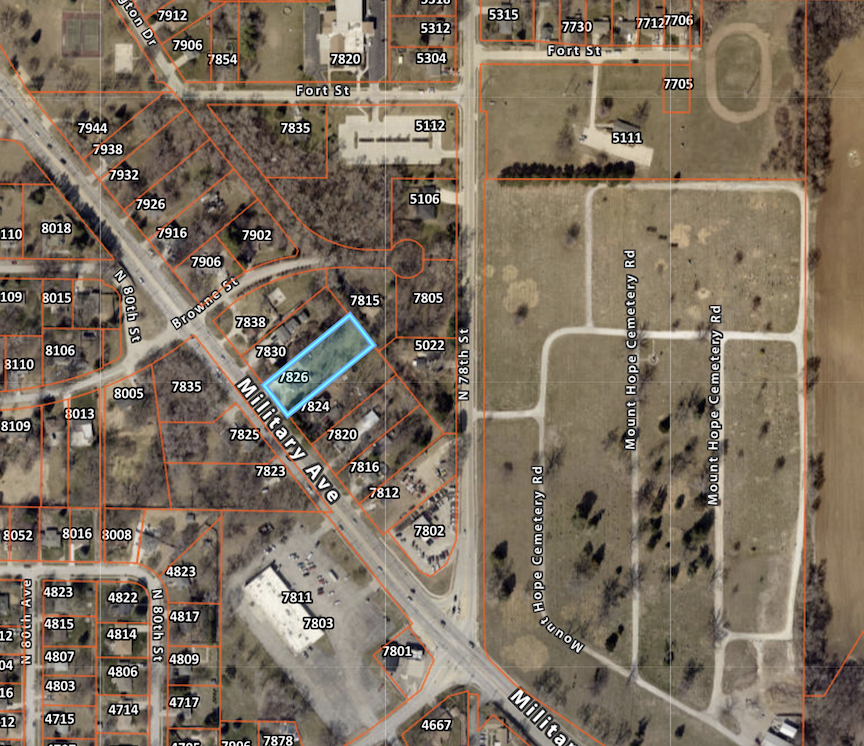
Outlined in bright blue, 7826 Military Avenue, like the surrounding parcels, is a long lot with room to roam. The property was one acre in the late 1950s. I believe the Hasenkamps had more land when they bought the lot.
The initial benefit of this property was its secluded position, offering rural living in proximity to the city. The couple had designed a magnificent home with spacious rooms—an attractive living room with a beautiful handout and polished stone, woodburning fireplace, paneled doors, a rich parquet floor, two elegant bedrooms, a breakfast nook, a walnut trimmed den featuring built in bookcases, a paneled wall with a built-in writing desk, floor-to-ceiling bay windows, an enclosed sunporch off of the den, a lounge, a completed basement featuring knotting pine—the rumpus room of my dreams!



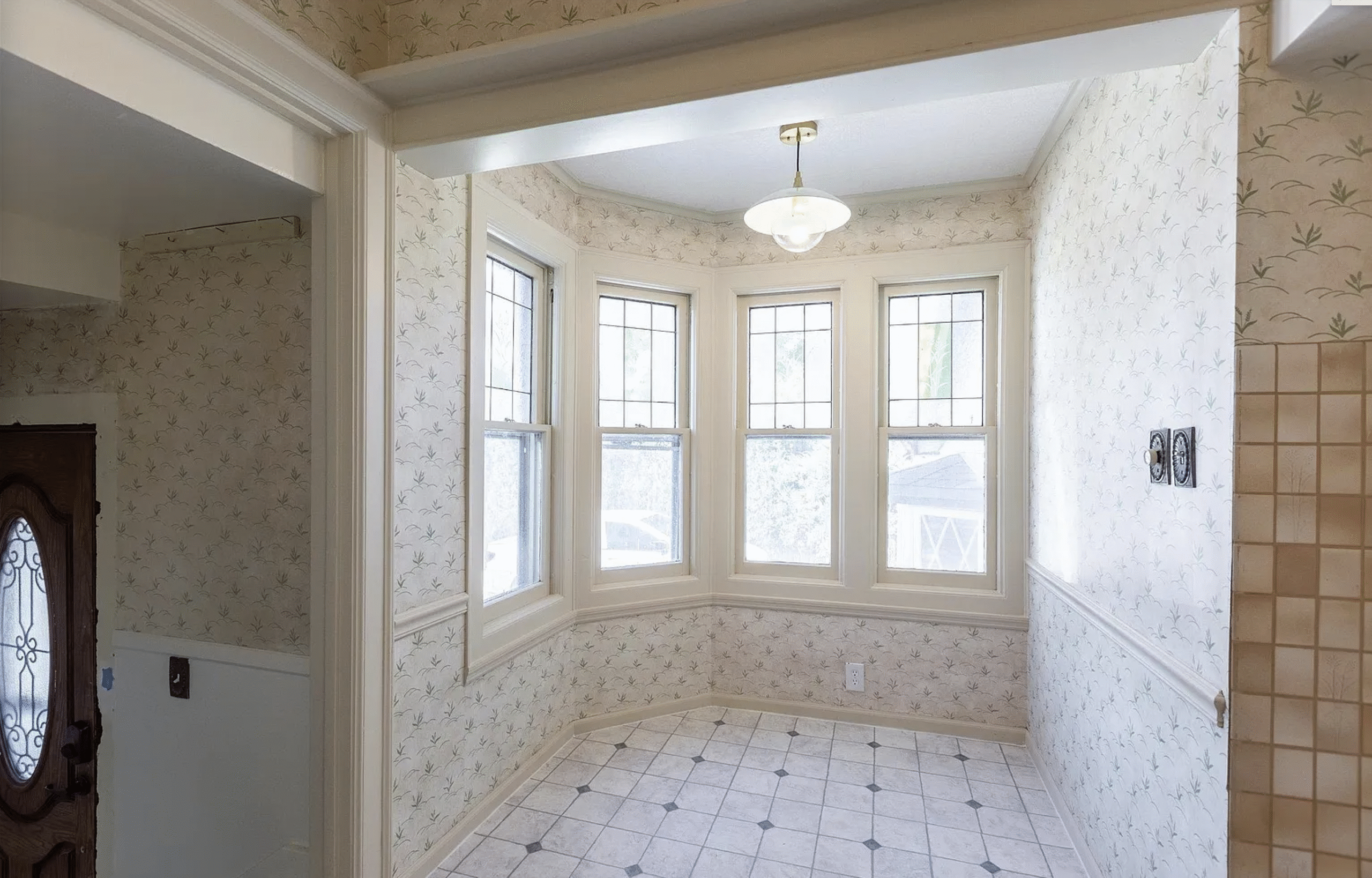
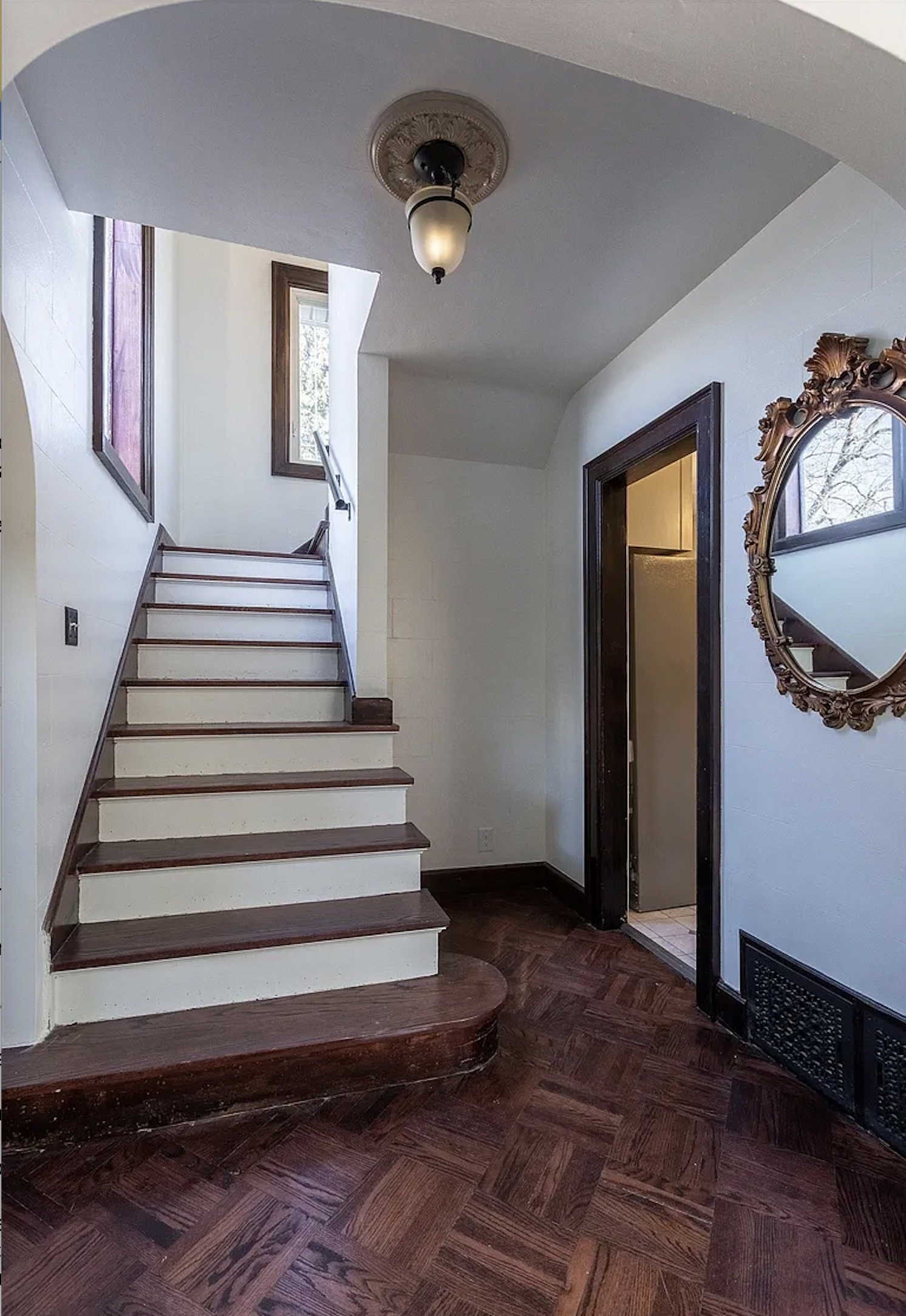
I have to admit, I was more imagining something like this (below) in grade school.

But that was not all. The Hasenkamp couple had thought of every detail for their large country property, outbuildings outfitted to their every specification—a four-room summer cottage built in the English Colonial style, a craft shop, a brick terrace, a secluded picnic area, expansive garden plots filled with abundant flowers and shrubs, pony stables equipped with a riding arena. “Proximity to tranquil rural roads for leisurely horseback riding or walking.” This stable and pony bit was a tradition of the old Keystone neighborhood that remained even into my early adolescence. It was common to see people riding horses in this area. “You can barbecue steaks under the shady Chinese elms and birches. Many fruit bearing trees and grapes.”
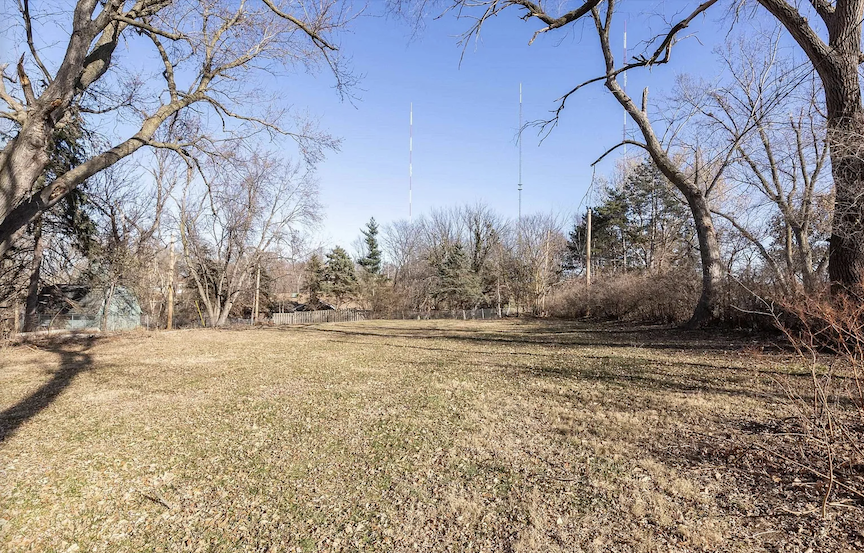
What is left of the back yard.
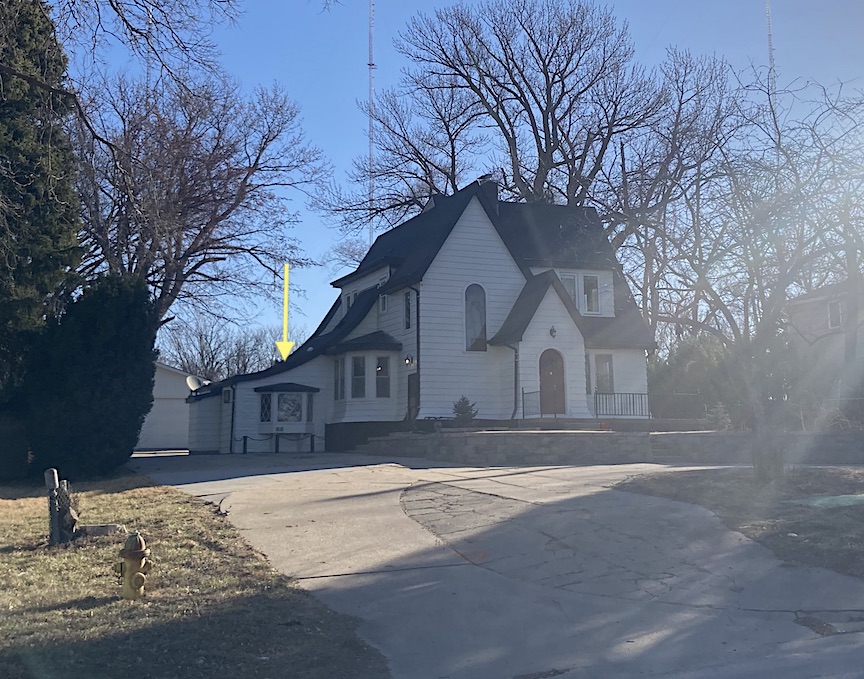
There was a built-in garage with drive through on the westside of the home. This garage is something that has been altered over time. It was still present in my youth but now there is a two car garage around behind the home.
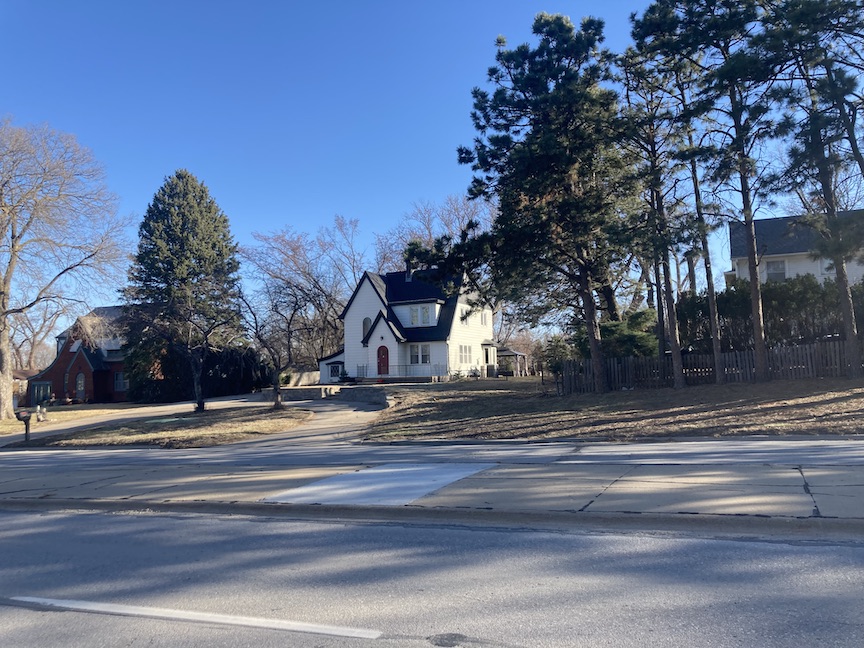
The 7826 Military Avenue home was more desirous than I had known.
Mr. Hasenkamp died in 1952 at age 68. Mrs. Stella Hasenkamp remained out at their large property until she sold the place in 1954.
From 1954: “Let’s Head for the County. Let’s get away from it all in this sparkling two-story English Colonial Country Home. As pretty as your wife with personality to match, this Two-bedroom home should really please her! Featuring a cheerful breakfast corner and separate dining room.”
It sold again in 1957.
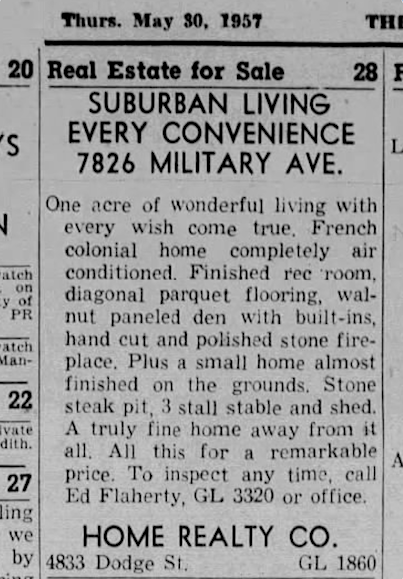
1957. Omaha Sun.
7826 Military Avenue has been sold and resold and a number of times since. The history of one of the owners is within my recent investigation: Mysteries of Omaha: 1503 Park Wild Avenue.
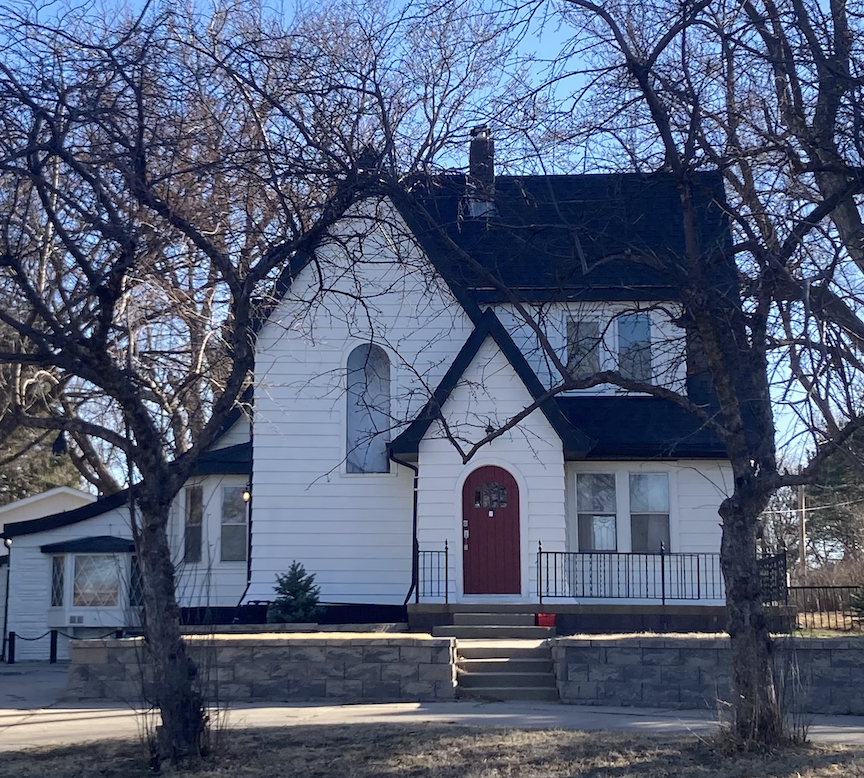
Thank you, Miss 7826 Military Avenue, for giving me so many happy childhood moments.
6709 Mason Street
The dollhouse located at 6709 Mason has captivated me since the 1990s. I cannot recall how I first encountered her, as she is not easily found in passing. I believe you will concur, with easy eyes, that 6709 Mason merits inclusion on our dollhouse list. Like a Spanish style Barbie house, I get strong senses from this one. Records indicate she was constructed in 1935 in the Elmwood Gardens addition; nonetheless, a family resided at her site both prior to and subsequent to that year. There was a whole cast of characters that I would work to sift through.
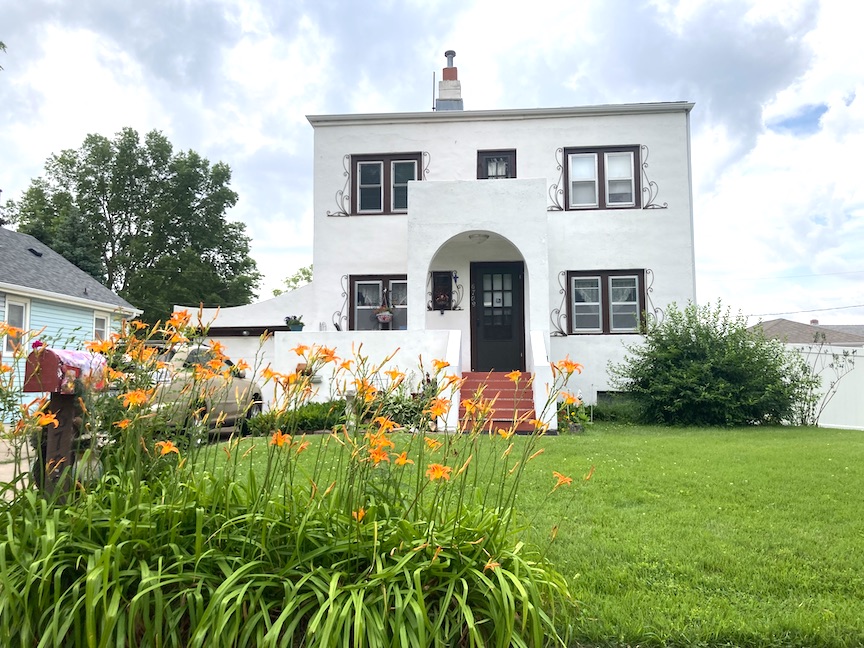
Carl Edwin Ekman, born in 1894, was a steamfitter in South Omaha’s packing business. (Later clues led me to Swift Packinghouse.) He wed Marie Ella Clark in 1924 in Council Bluffs, Iowa. Carl’s father, Johan Linus Ekman, was born in Sweden and married Augusta Anderson Ekman. Of note Albert Willard “Bill” Ekman, Carl’s brother, resided at 6709 Mason Street in 1925. Was it an alternate residence, then demolished and reconstructed as the magnificent white dollhouse before us now? Or is 6709 Mason Street older than reported. Of interest in May of 1935 while living at 6709 Mason, Mrs. Marie Eckman filed for divorce from husband, Carl, alleging “non-support.” The Bee News let on she went to district court and charged Carl was “always in the company of persons of ill repute and entertained his friends in bootlegging joints.” The couple must have ironed out these troubles or found a way to deal with each other because at the time of the 1940 U. S. Census, they were still living at 6709 Mason as a married couple.
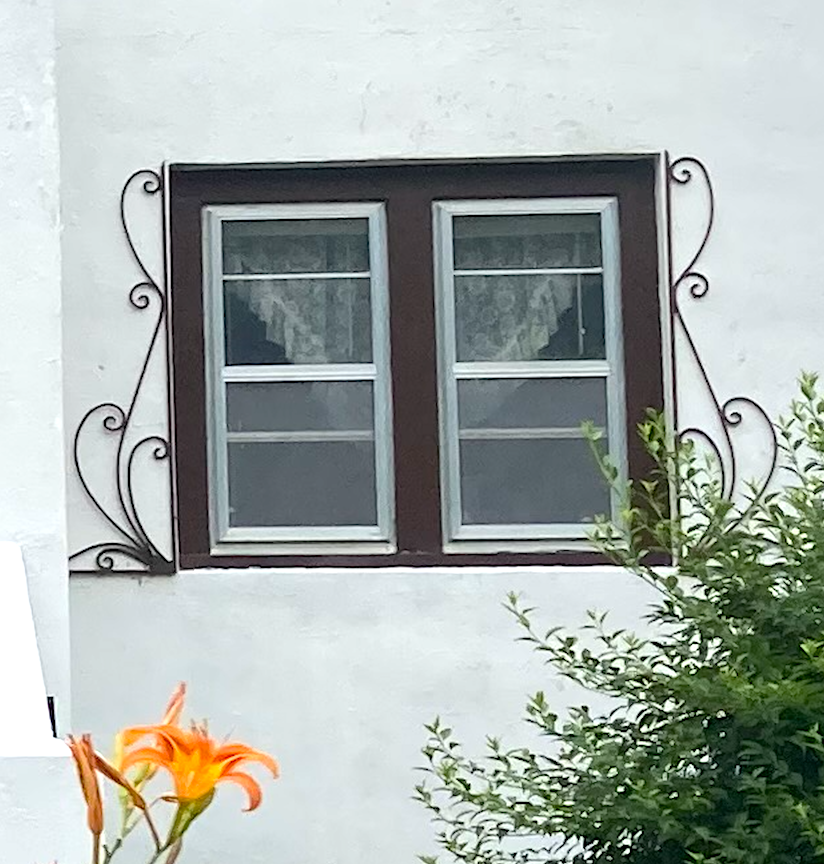
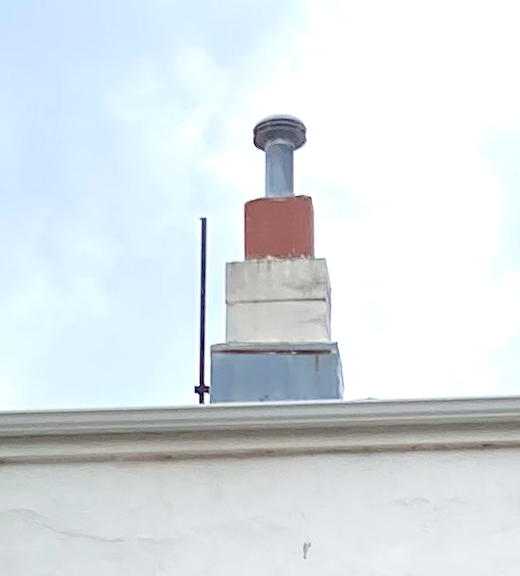
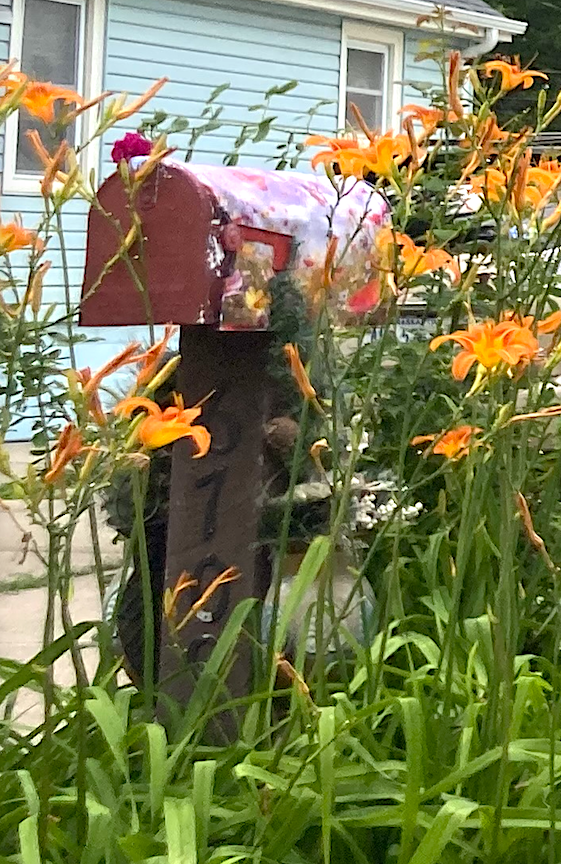
Other than the icy white structure itself, giving a real California sensation, these are some key characteristics that I just die for. This home is such a sweet delight. The charming curly-q ironwork treatments around the windows lend whimsy. I also love the front door and the little window to the left. The artistic mailbox and even the chimney winks dollhouse!

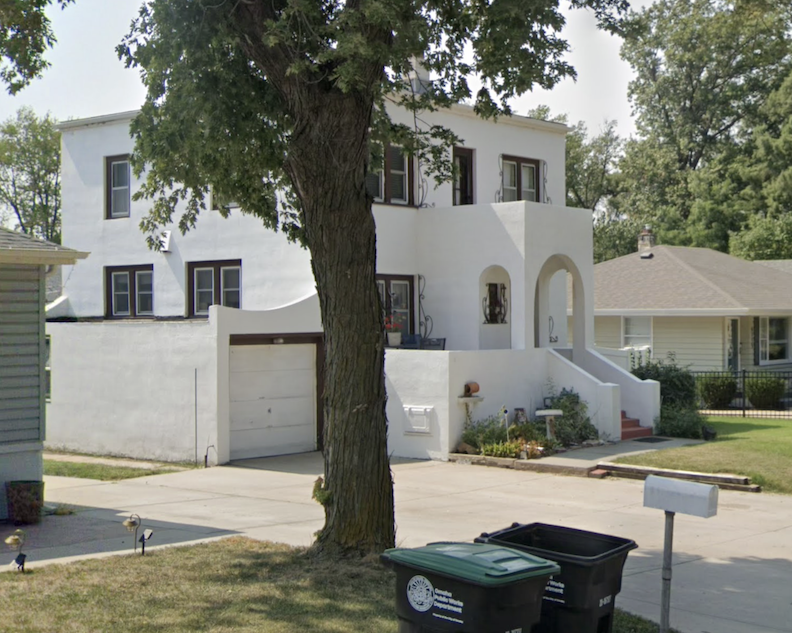
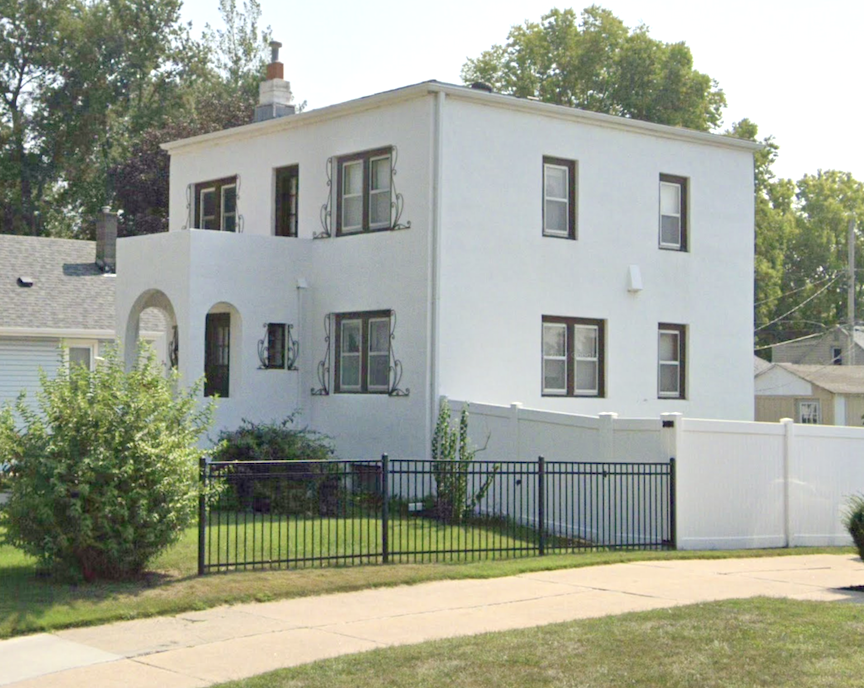
There are lovely balconies in front, over the entrance and in the rear.
Part of the query is that when the house was put up for sale in 1956, it was described as fifteen years old. The construction date would be around 1941. It is reported that the residence features four bedrooms and is a Spanish-style property with two balconies. A basement apartment exists. Two-car garage. Loving formal dining room. It is said she is built of poured concrete walls and floors. Completely insulated. “Built to last forever” and “SOLID AS A FORT.” I must know more.
A single family of consecutive relatives has held this unique residence since the early 1950s, if not earlier.

Radford’s Cement Houses and How to Build Them. Illustrated. Chicago, 1909.
**Addendum of July 12, 2025**
I was so pleased to hear from Grace Lakota Anne Hans Pawol, the owner of 6709 Mason Street. I was already acquainted with her and her family from my research; yet, in accordance with my professional etiquette, I generally refrain from disclosing details about current owners. She provided numerous insightful clues, typically known only to family members and owners, and she has allowed me to share this information. Her father, Fred M. Hans, purchased the lot when it was designated as 6707 Mason Street. Mrs. Ekman resided to their west; her residence was later consumed by fire. The Hans family subsequently acquired the Ekman lot. Upon the addition of two residences to the east of 6707, the Hans family was instructed to alter their address from 6707 to 6709 Mason, which they did. “The white 2-story house was, personally, poured by my dad. It took him a decade, as he was working a fulltime job. This heirloom home is one of a kind.” I had inquired about the lot size, as I have read again and again that it had been quite large at one time. She explained that the current lot size is 60X100 because they had sold the Ekman property to the west. “I, Grace, was born Dec. 1, 1936, and bought the house to live in the basement. I’m 88; still in it.” Grace has planned to leave this incredible home that her father built to her five children.

This is a photograph of young Grace Lakota Anne Hans that I found during my research and kept in a file. Isn’t she lovely?
Thank you, Grace!
6148 Western Avenue
6148 Western Avenue has been obscured by foliage for quite some time. I will admit, I had never managed to obtain a clear view, nor had I even considered investigating further. But in recent times, she has been illuminated to disclose her authentic nature—that of an illusory dollhouse.



The previous three photographs show 6148 Western Avenue in her more hidden environment.
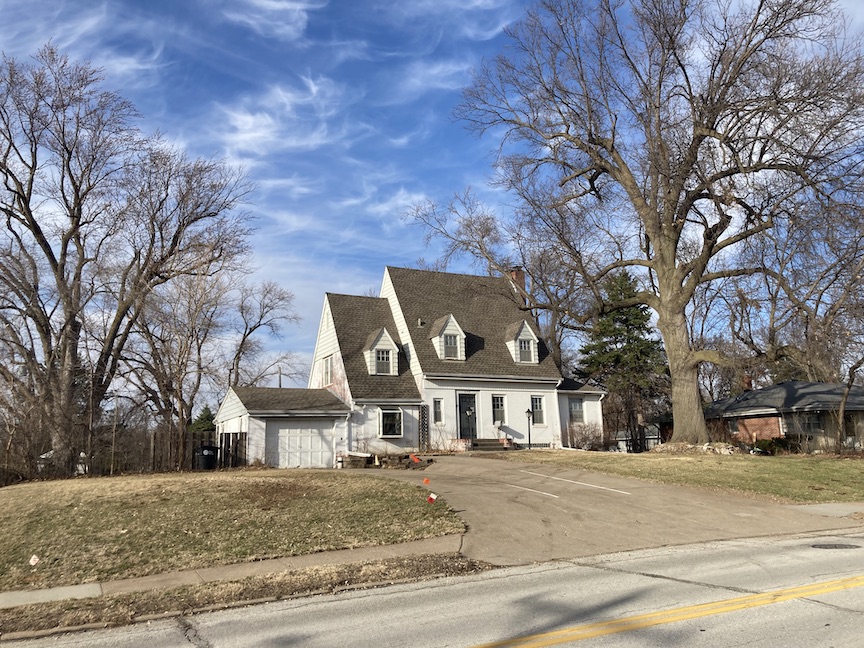
It wasn’t until this last winter, in the starkness, that I could see her properly. Steeper than steep pitched roof. Beautiful doll dormers. Flat, miniature model façade. Isolated view. Quite unlike anything built around her. There was so much to share about 6148 Western Avenue but I will aim to make this as brief as possible, still hitting the highlights.
N. P. Dodge & Company initiated the sale of parcels in the Morningside Addition, of which 6148 Western Avenue is included, in the early 1900s.
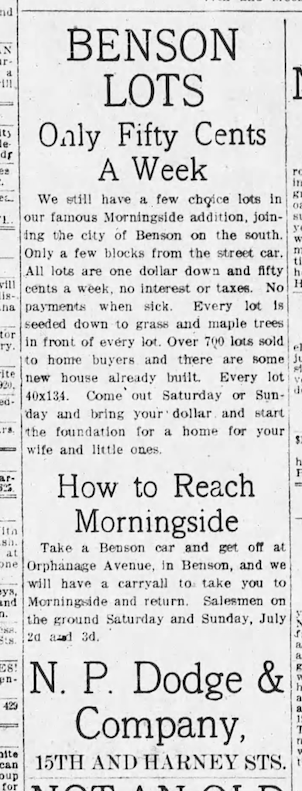
July 1920. Omaha Daily News.
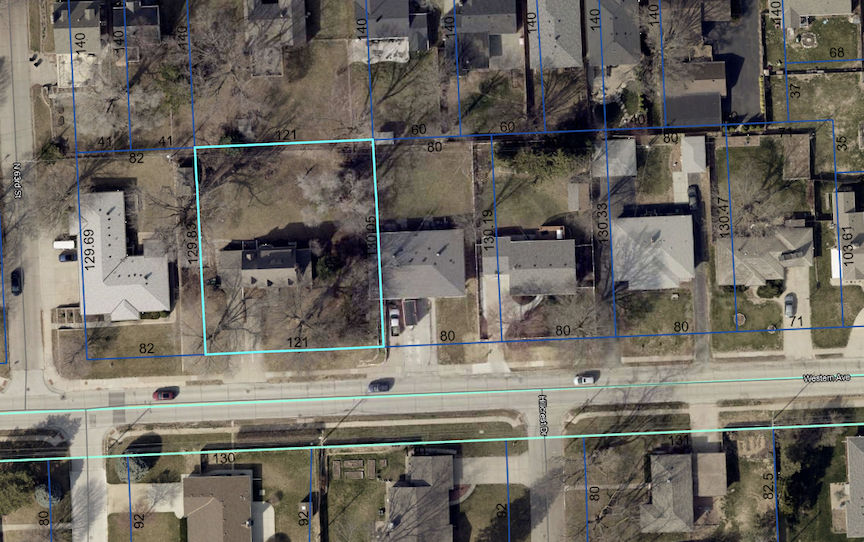
6148 Western Avenue is highlighted in blue. Image borrowed from the Douglas County Assessor site.
It was not until August 1937 that the lot on which the dollhouse is located came to my attention, prompted by a peculiar notification from Attorney Thomas Zacek. Non-residents and unidentified defendants, James J. Gafford and wife, heirs, devisees, and others with an interest in the Estate of James J. Gafford, deceased, asserting claims to Lots 952, 953, and 954 in the Morningside Addition. Thomas Zacek submitted a petition about the aforementioned property estate.
An unusual event, given that an identical public notice was issued regarding the estate of the late Lizzie E. Gafford in August 1920. These three parcels were to be offered at public auction. In addition to a parcel in the Bemis Park neighborhood of Omaha, Lizzie possessed land in Canyon County, Idaho.
To complicate matters in March 1918, Evening World-Herald announced James J. Gafford, a butter and eggs broker, killed himself in the family home at 1024 North Thirty-fourth Street. Daughter June assumed he committed suicide, despondent because of the recent death of his wife, Mrs. Elizabeth “Lizzie” Gafford. The family maid, Mary Gerhardt, told Deputy Sheriff Meade that Mr. Gafford, age 50, was upstairs sleeping. When Meade entered the room, Gafford was dead with a bullet wound in his temple and a discharged revolver by his side. Children: Mrs. William Carbach; Frances, 11; June age 23. Jack, 9 and Jarvis 18. Lizzie Gafford, I would discover died at the age of 45 from unknown causes in March of 1918 at the hospital.
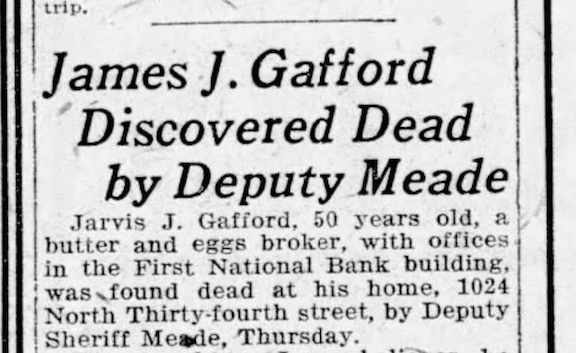
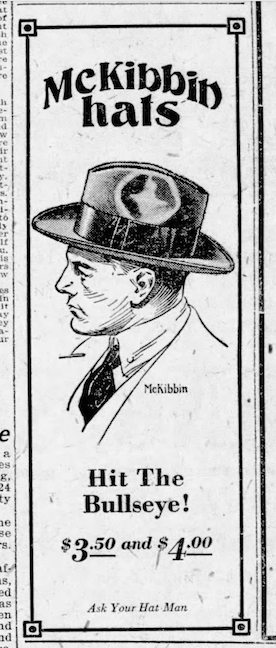
March 1918. Evening World-Herald. I provide these two images collectively as they were located adjacent to one another on the same newspaper page. An advertising stating “Hit The Bullseye!” positioned next to a descriptive article concerning a bullet wound to the temple.
The last time I found James J. Gafford in the archives, Attorney Zacek was progressing with his quiet title action, which is a legal proceeding designed to establish unequivocal ownership of a property, particularly in the presence of conflicting claims or ambiguities regarding the title. It effectively “resolves” any disputes or assertions regarding the property’s title, culminating in a judicial decree that affirms the legitimate owner. I encountered Attorney Thomas Zacek in the newspapers frequently as the legal representative of Omaha Loan & Building. So whether his business transactions or personal, in September 1937, Attorney Zacek and his wife sold lots 952 and 953 in the Morningside expansion to Kenneth Rankin and his wife. I was intrigued to see that Kenneth P. Rankin, musician, relocated to Omaha from Lawrence, Kansas, to serve as an assistant to Dr. D. E. Wiedman, who oversaw the educational initiative for the 80,000 men in the CCC (Civilian Conservation Corps) camps within the Seventh Corps region under the expanded program in 1935. Dr. Wiedman hailed from Medford, Oregon, where he served as the district CCC advisor.
I believe that the Rankins built our residence at 6148 Western Avenue; it was constructed in 1938. A private wood existed to the west. The aerial photographs from 1938 indicate that this was the sole residence in the vicinity. A charming brick house situated in an “prestige area,”, reportedly with a wood-burning fireplace. “Unusually spacious,” a paneled library, formal dining room, a photographer’s darkroom, a “picturesque studio” with on the third floor featuring a “remarkable ceiling” and a skylight facing north for artists, four bedrooms, a large flagstone terrace, and three bathrooms. A number of these MCM features were added over time. Be still my heart.
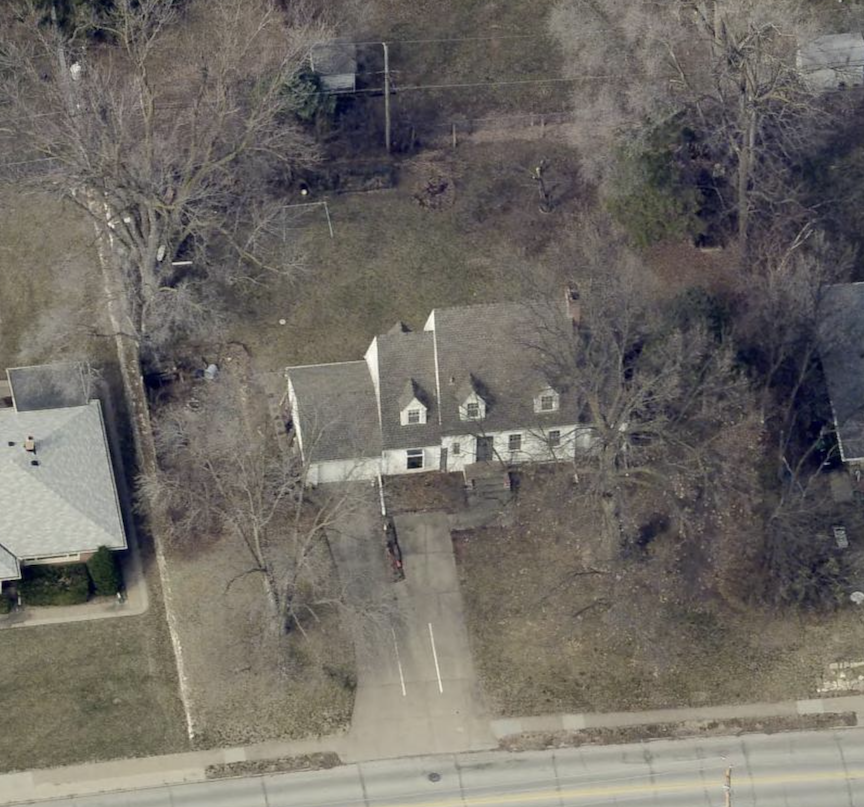
DOGIS aerials from 2024. Southern elevation.

DOGIS aerials from 2024. Eastern elevation.

DOGIS aerials from 2024. Northern elevation. Bingo! Skylights.
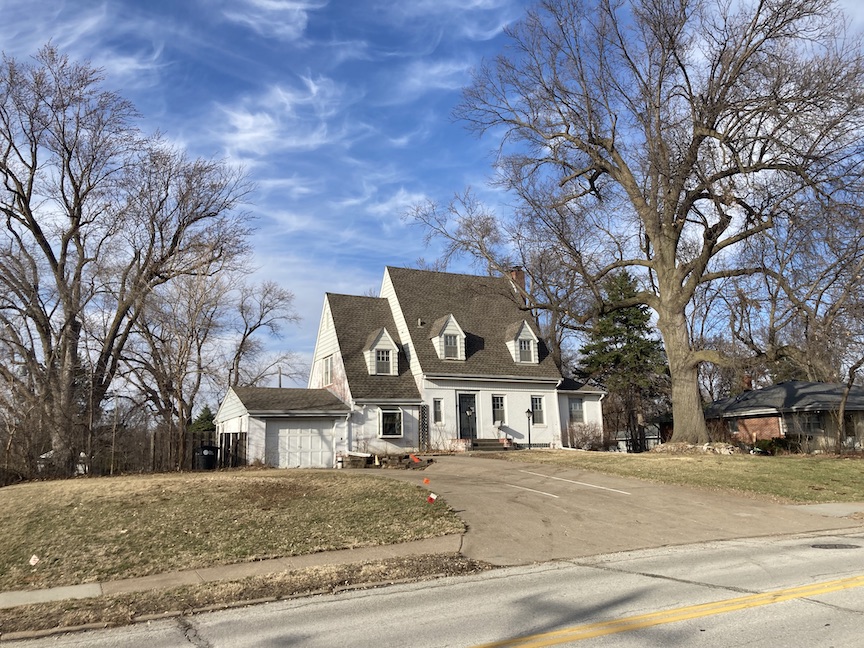
In August 1942, Kenneth P. Rankin and his wife sold lots 952 and 954 to Cordelia B. Elliott for $8,350. In September 1942, Cordelia Elliott purchased lots 950 and 951 from Harold L. Gaskill and family. By 1955, the adjacent ranches to the east and south had been constructed. In 1959, Cordelia B. Elliott possessed lots 950, 951, 952, 953, and 954, while Lyda B. Graham owned lots 955 and 956 of the Morningside Addition.
Let us back up a bit to another matter of scandal… a side story that Will Eventually Connect–
Loring Elliott was born in 1894 in Kearney, Nebraska. Edwin E. Elliott and his mother, Cora A. Johnson Elliott, reared young Loring and his siblings, Corinne, Elizabeth, and Geraldine, within the upper echelons of Omaha society. During their adolescence, siblings Miss Corinne and Mr. Loring hosted gatherings at the Happy Hollow club. They were also members of the Omaha Country Club. Loring Elliott was said to be a graduate of the University of Nebraska. Loring’s engagement to and subsequent marriage to Miss Helen Hoagland, granddaughter of the renowned Omaha Famous George A. Hoagland, a magnate in the lumber industry, and daughter of William Hoagland, was deemed The Wedding of the Season in 1924. I have written of the Hoaglands in my book and in previous investigations.
The Loring Elliotts and their three daughters kept trophy horses and bred award-winning German Shepherds, which Mrs. Elliott especially favored, showcasing them at national competitions. The affluent neighbors, however, did not value Helen Hoagland Elliott’s enthusiasm for dogs and their incessant barking emanating from the large Elliott property in Dundee, which did not bode well. By April 1941, the community dropped a dime, as they say, on Mrs. Elliott, relinquishing her destiny to the authorities.
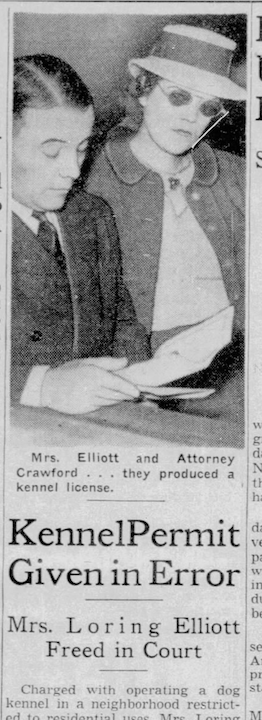
April of 1941. Mrs. Loring freed in court. Kept four German Shepherds kenneled in her neighborhood. “Prominent society woman and widely known breeder of German shepherd dogs.” Just look at her. She reminds me of my favorite, Sunset Boulevard or Bette Davis in divorce court.
In May 1941, one month later after the police picked her up over the dogs scandal, Mrs. Helen Hoagland Elliott filed suit to separate from Loring Elliott. She alleged mistreatment and sought custody of their three children along with financial support. At that time, she had assumed the presidency of George A. Hoagland & Co., lumber merchants whereas Loring Elliott served as the assistant to the secretary of the Physicians Casualty & Health Association. A month later in June of 1941, Loring filed for formal divorce and custody stating Helen Hoagland Elliott had tried to shoot him, had once bit him, had knocked him down. However, Mr. Elliott had the most grievances regarding his wife’s dogs. He asserted that she allowed those German shepherds to roam freely in the house at night.

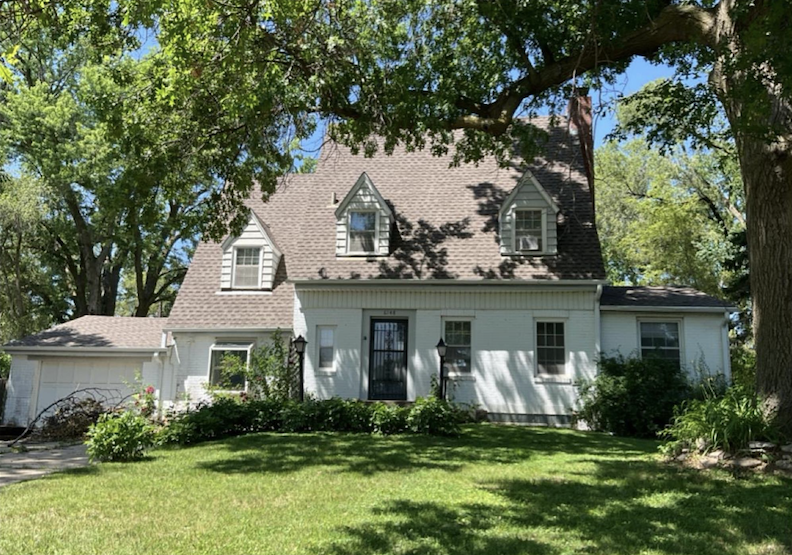
The divorce of Helen and Loring was finalized in September 1941, and by April 1942, Loring Elliott secretly married Miss Cordelia Bing. As a gentleman of society, the entire situation was peculiar. I would imagine that Helen Hoagland sought retribution within the country club elite or maybe his decisions were based on his own safety, rather than shame. The Elliott-Bing marriage was revealed in an unusual manner in newspapers in July 1942.

1939. Omaha advertisement.
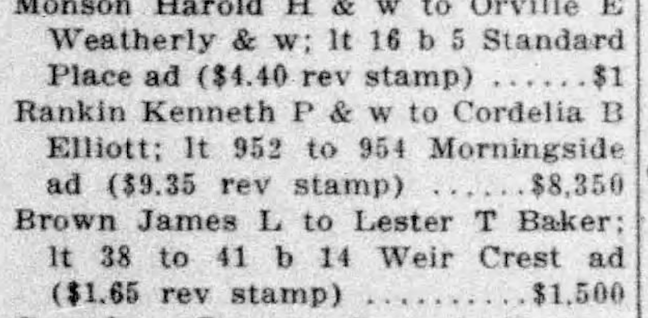
1942. The Daily Record.
Cordelia Bing Elliott appeared to buy up these Morningside parcels as an investment in 1942. I discovered that the new Mr. and Mrs. Loring Elliott resided at nearby 6128 Western Avenue. But the Helen Hoagland Elliott narrative was not quickly washed away as she and Loring continued to battle it out in the courts and newspapers into the 1950s. Child support, custody of young Medora Elliott and related matters were dragged through the mud to public scrutiny. Suddenly ex-wife Helen Edith Hoagland died in June of 1953 under unknown circumstances.
Then Cordelia Bing Elliott filed for divorce from Loring Elliott in May of 1954, similarly siting mistreatment. There was a Quit Claim Deed filed from Loring Elliott to Cordelia B. Elliott for lots 950, 951, 952, 953 and 954 of Morningside. That February of 1955 the divorce was granted.
A peculiar conclusion to the bizarre, convoluted narrative was that one year later, Loring Elliott resided in the Omaha Athletic Club at 1714 Douglas. The explanation was said that he stumbled and fell into a window at 11:40 PM, resulting in facial lacerations. If this does not suggest any desperation and I am merely interpreting the situation, then these are simply the assembled facts. Loring’s father died in February of 1961 and a few months later Loring retired from Physicians Casualty and Health Associations where he had worked for 47 years. Within the year, Loring Elliott died in his Blackstone Hotel apartment under unspecified conditions. A survivor, identified as “Deborah,” was briefly referenced, although that relationship had also remained confidential.
The current owner bought Miss 6148 Western Avenue in 1990 and has no doubt enjoyed the Morningside dollhouse all these years.
1412 North 143rd Avenue
The new Victorian at 1412 North 143rd Avenue is not typically an architectural subject I would address in the My Omaha Obsession inquiries. However, other factors contribute to her inclusion today. The Pink Lady, located at 1412 North 143rd Avenue, is a unique residence constructed as a passion piece in the Linden Estates neighborhood. Her pink hue, her positioning on the parcel, in isolation from her neighbors, her ornate architectural style, her elusiveness dream mystery and the lavish affection from her owners categorize her inside the dollhouse spectrum.
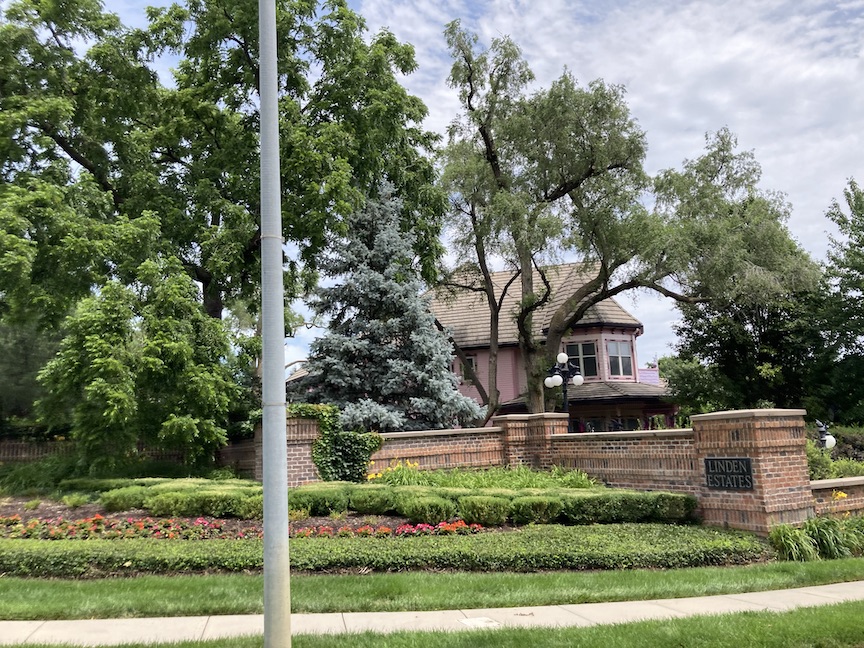
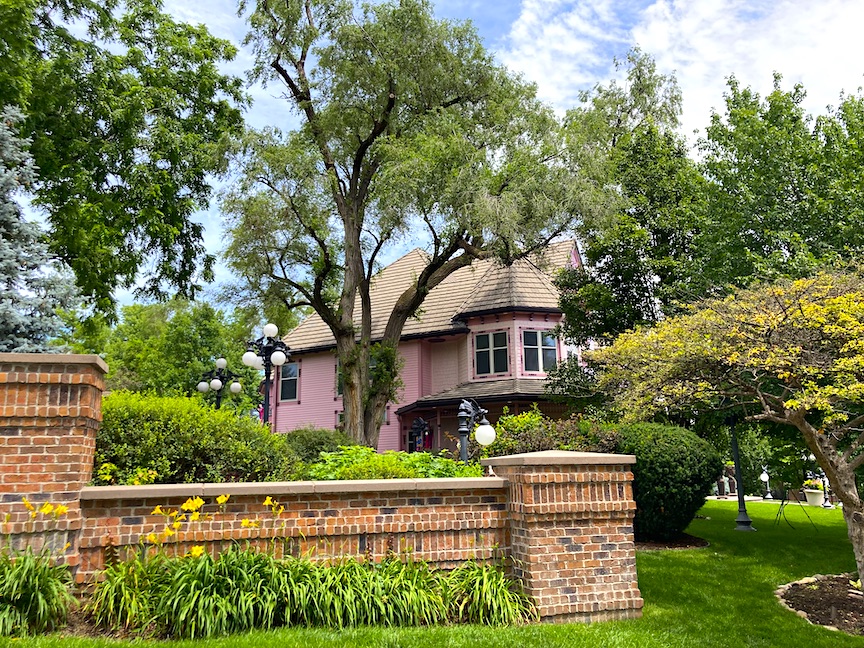
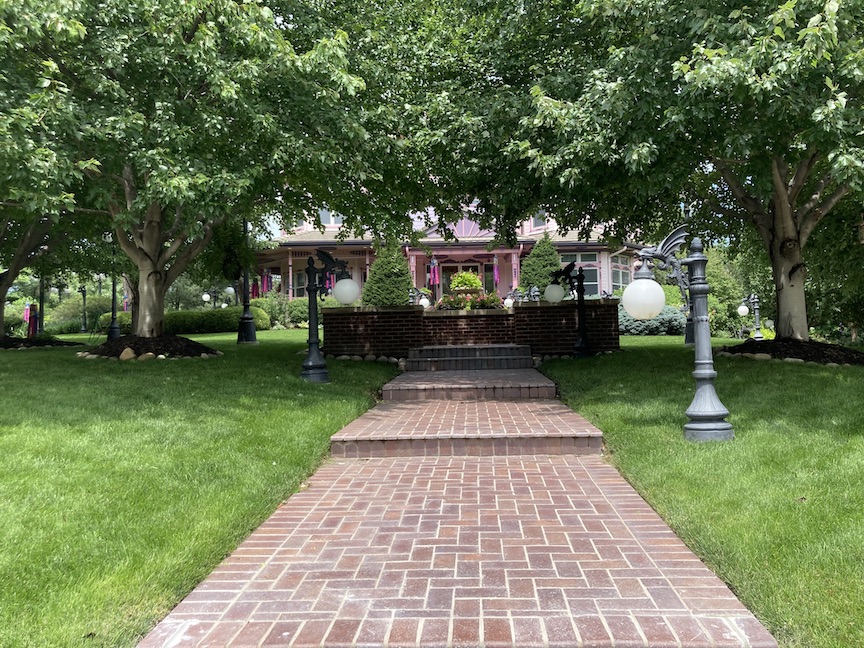
She has traditionally remained hard to get a gander at, all by design, I am sure, but the aerial photographs to follow make plain—this is a meticulously crafted Dollhouse of the finest caliber.
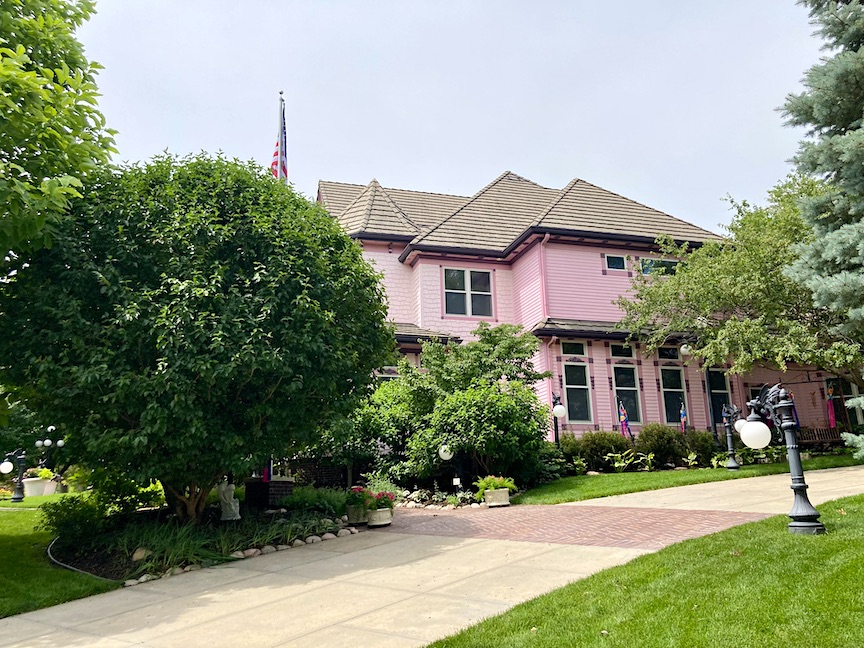
Northern elevation.
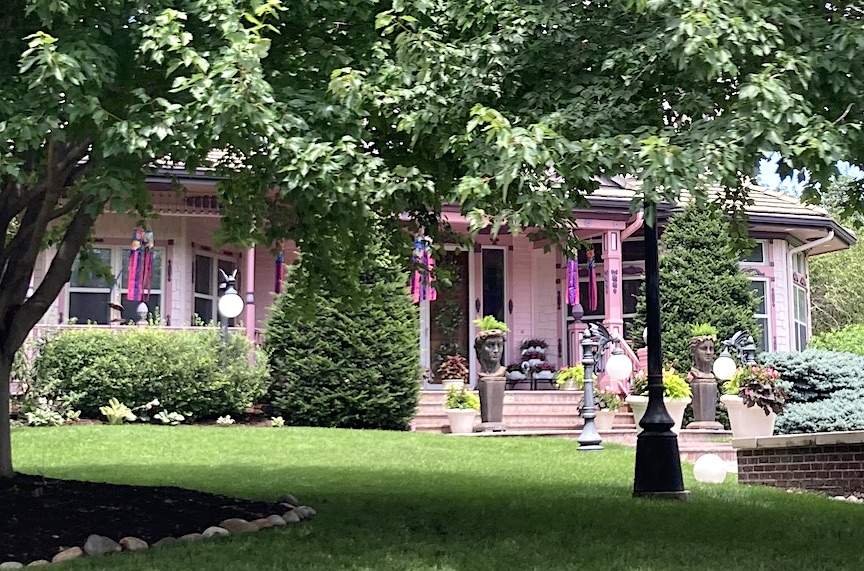
Front wrap around porch.
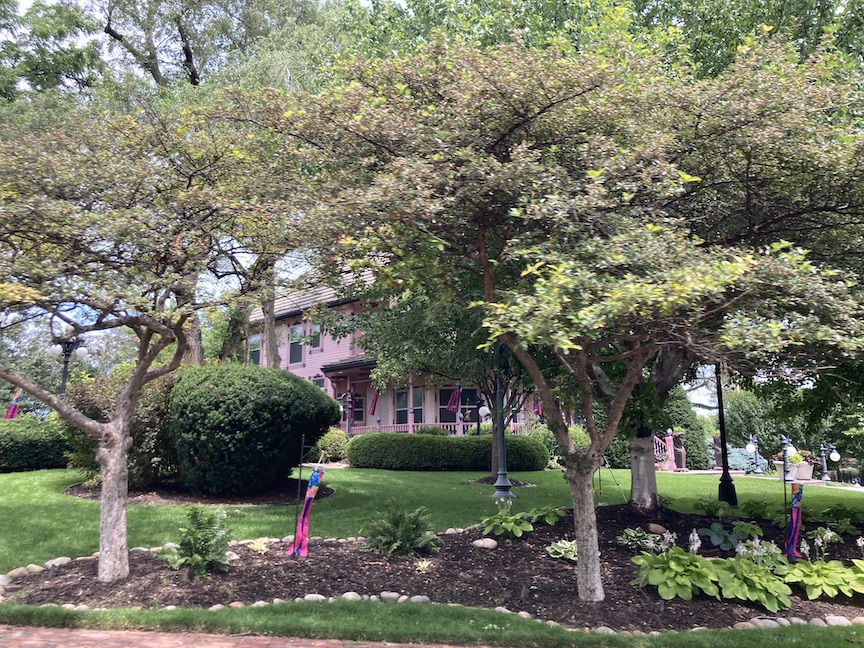
Southeastern corner of the wraparound porch.
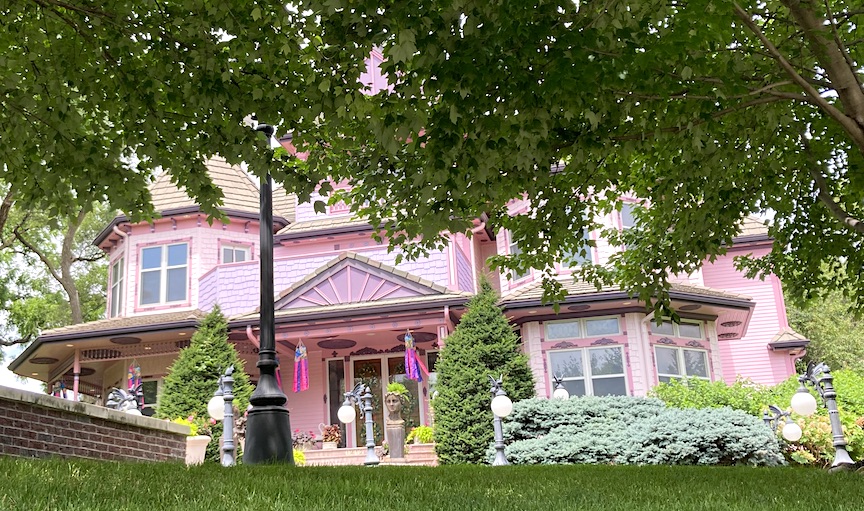
Lots of yummy details around the front doors and look at that gingerbread.
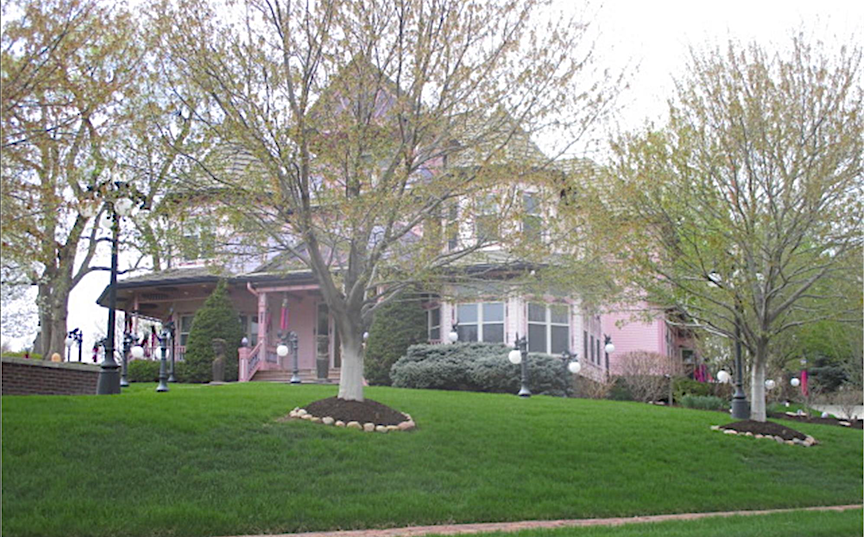

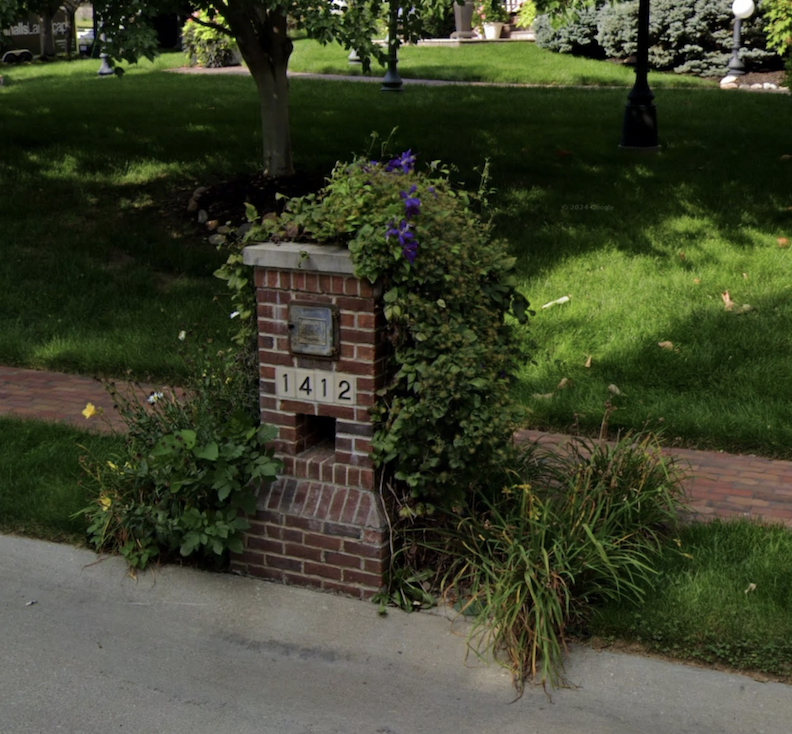
The site at which this home is located was originally a far reaching farm, potentially a gentleman farmer’s land. It had all but vanished by the early 1990s. This was pre-Linden Estates. The couple who would come to call 1412 North 143rd Avenue home had collaborated meticulously with R. E. Czerwinski Construction from 2000 to 2001 before putting in a building permit, in order to design and construct a totally modern Victorian replica. The couple has owned historic homes in older districts of Omaha and have a firm handle on their architectural interests. The construction persisted throughout 2003.
1412 North 143rd Avenue has 5,431 square feet, perhaps exceeding above ground measurements. It comprises four bedrooms and five bathrooms. The residence was initially a charming pale yellow and white, but between the 2016 and 2018 time period, it was repainted in pink with purple accents. While enthusiasts of Victorian architecture appreciate the application of these bright hues to accentuate her many intricate features, it is my perception, in the kindest terms, that some individuals contest the selections at 1412 North 143rdAvenue. The numerous vintage-style lamps featuring pink bulbs, along with the newer, diminutive gargoyle lamps, enhance the dream-like qualities. Artistic, free, fun—whimseys one might expect to see only in older parts of Omaha. Some may critique this property without comprehending the history of pink houses from yesteryear or simply wringing their hand over an HOA untethered; nonetheless, I have assumed the owners are adopting the Painted Lady aesthetic or that somebody is a cancer survivor seeking to celebrate or commemorate their journey.
These are the historic aerials.
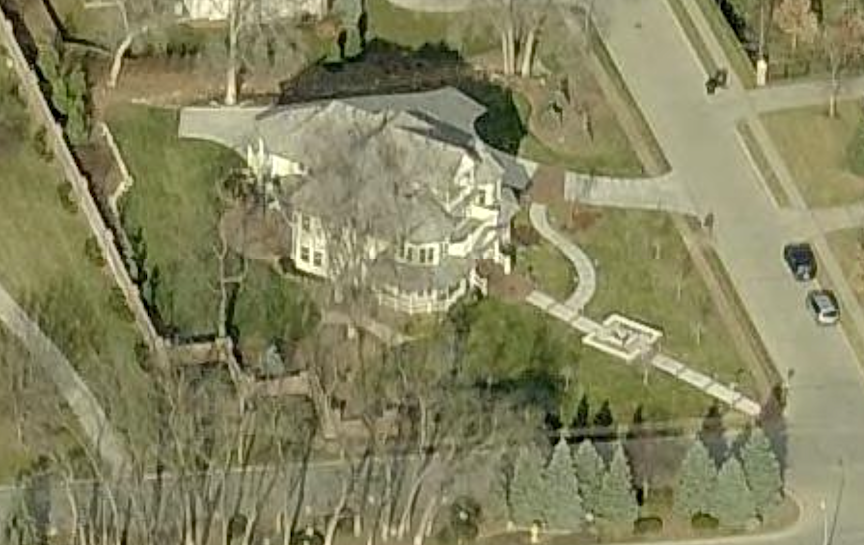
December of 2006. Pale and worthy of a doll.

2010. Lovely details in this one. I would think this a miniature model if you just showed me this photograph, right down to the postal truck.
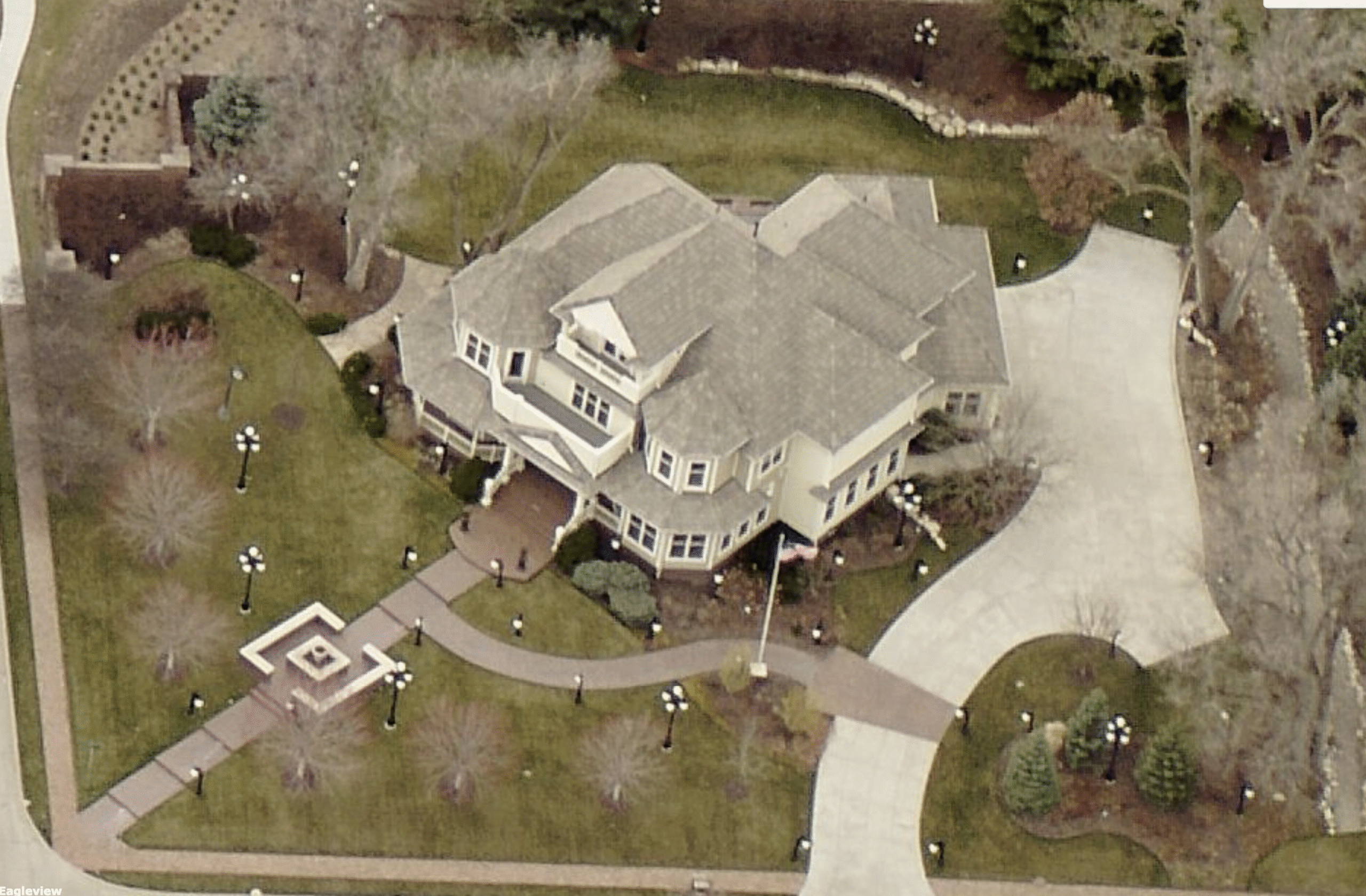
By 2016 the big globe lampposts and gargoyles arrive and are stationed throughout the property.

At the time of the 2020 aerial, the home is seen in pink and purple.
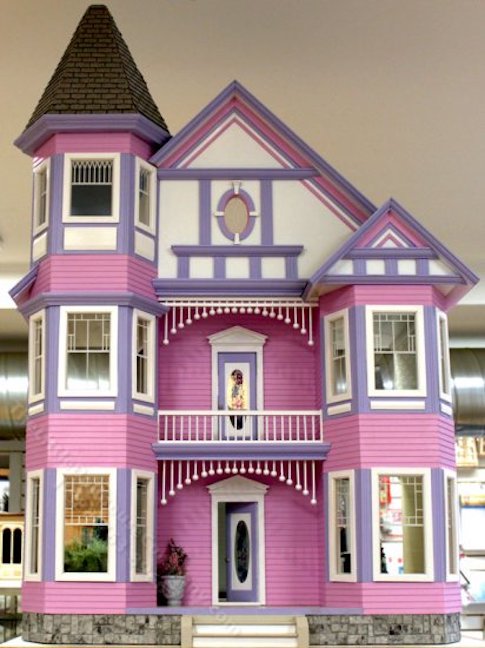
For reference on 1412 North 143rd Avenue.
I suppose we had better head home for the night. What fun that was. Stay curious and keep an eye out. I thank you for joining me.
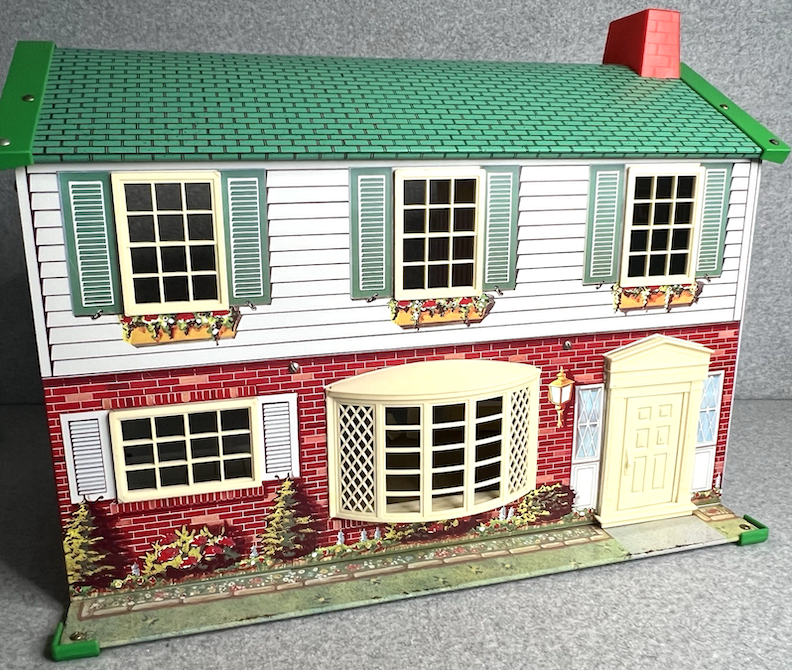
1950s Wolverine tin dollhouse.
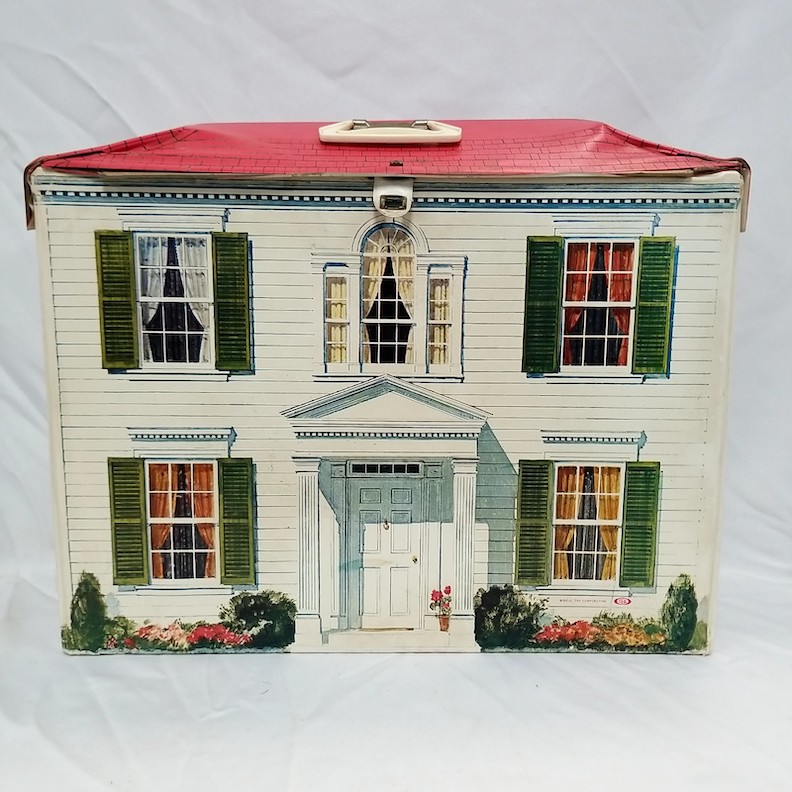
1960 Ideal Petite Princess dollhouse.
I welcome your feedback and comments on these great Dollhouses of Omaha. If you are an owner of one of these fine homes or if you know more about one of these structures and want to add to the article, please share your additional clues to the story in the “Comments.” If you have a dollhouse you have spied and might want to add to the list, please make contact. Everyone would love to read what you have to say, and it makes the sharing of Omaha history more fun. You can use an anonymous smokescreen name if need be. We want to hear from you.

Accept no substitutes, hacks, AI or otherwise. Check back often for the real deal. The Real In-depth Deal. You can keep up with my latest investigations by joining my email group. Click on “Contact” then look for “Sign me up for the Newsletter!” Enter your email address. You will get sent email updates every time I have written a new article. Also feel free to join My Omaha Obsession on Facebook.
Thank you, Omaha friends.
Miss Cassette

© Miss Cassette and myomahaobsession, 2025 Unauthorized use and/or duplication of this material without express and written permission from this site’s author and/or owner is strictly prohibited. Excerpts and links may be used, provided that full and clear credit is given to Miss Cassette and myomahaobsession with appropriate and specific direction to the original content.
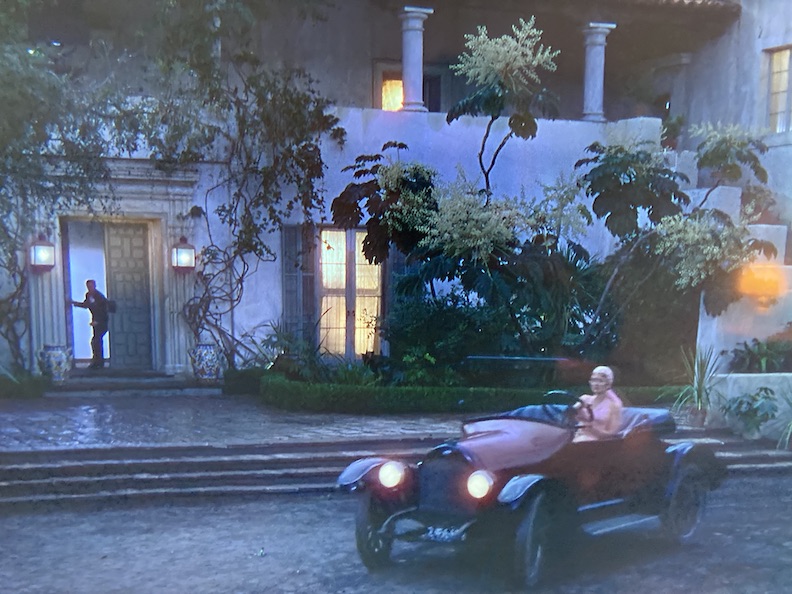
After working on this article, even the set in Singin’ in the Rain began to look like a doll’s house.
If you are looking for more architectural and Omaha history sleuthing fun, ask your local or bigbox bookseller for my book: My Omaha Obsession: Searching for the City. Also available everywhere online. Thank you.

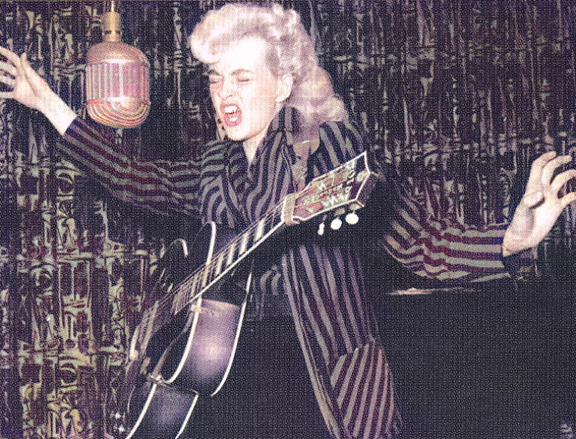
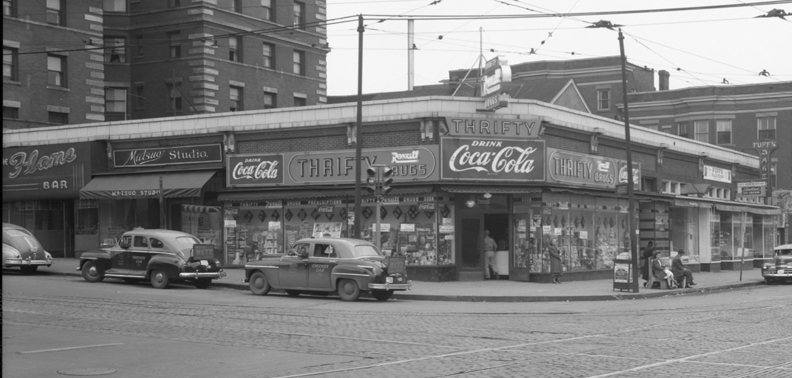
Snippy review of your book and website?! Please!!
Your approach to the subject matter is methodical.
Your research is impeccable.
Your love of Omaha history is immutable.
My wife and I have been, and will always be two of your most ardent fans! By the way, we love your book.
Well, you’ve made my heart swell up again! Thank you for being so kind and supportive. I am always delighted to see one of your comments.
I really enjoyed this post with so many homes I love! And you finish with my favorite movie-absolutely perfect!
Add my name to your fan list-always! Thank you for all your hard detective work- so well done and a great read.
I look so forward to the next adventure.
Hi Victoria! I am so glad that you liked this one. It felt good to finally put it out! Singin’ in the Rain….I had, of course, seen scenes of that movie through my life but the other night we watched it in full, beginning to end. What a treasure!! Loved it. We just watched Brigadoon last month. I think I have a mad crush on Gene Kelly. Always good to hear from you.
Hi Miss I’m not sure about 1951 but we lived at 5225 Military Ave in 1972 and the street signs said Military Ave.
I don’t know when they changed to NW Radial
Your stories are always great and I have your book.
Hello John! Thanks for writing in. The newspapers announced at the time they were changing to the “new” Northwest Radial on that date. Personally I don’t remember calling it that even by the late 1970s but I was just a kid–also don’t know exactly where the roads change over. It was confusing and funny to remember those days. Interesting to hear the street signs stayed up. I hope you have a good week. Take care!
I LOVE our Omaha homes, and the write up you did has answered numerous questions I have had driving through our city. I love your research and my father and I both enjoyed your book. Thank you for putting pen to paper (metaphorically speaking) to answer so many of my burning questions of Omaha. You are a gem and a great historian!
Hi Savannah,
Thanks so much for taking the time to write in. Your comment really made me feel good. I have so much fun scoping out these properties and then doing the research. It really feels nice to be appreciated! You may not believe this, but when I began I did write everything out by hand. I had to drop that after a couple of stories. It was way too much!
I hope you have a good week and please stop by again. Miss Cassette
Great article. Cute homes with thorough research on each. I love the history lessons on Omaha. Thank you.
Thank you, Rita. You are always so thoughtful. I hope you are having a nice, cool weekend.